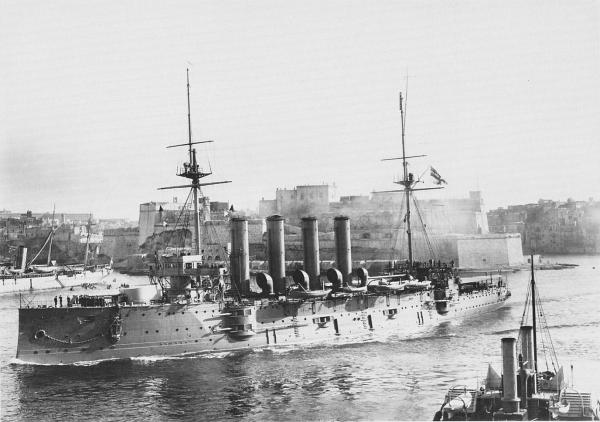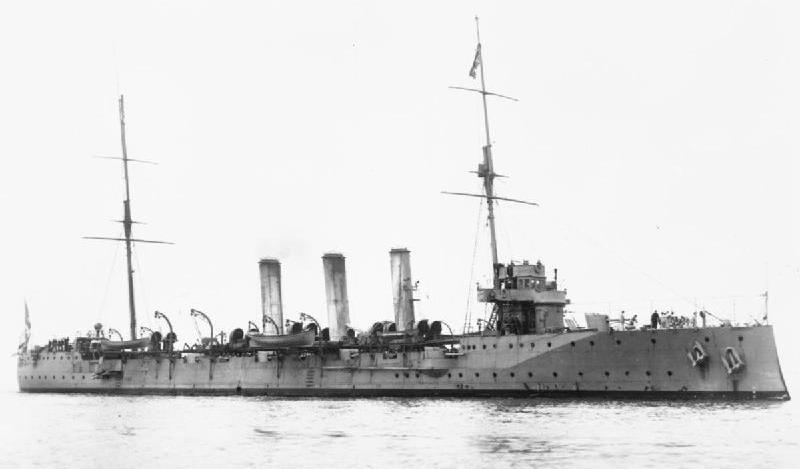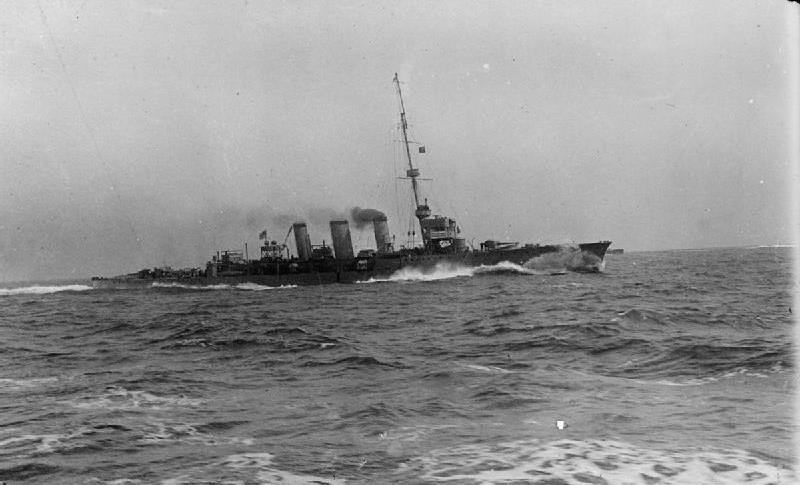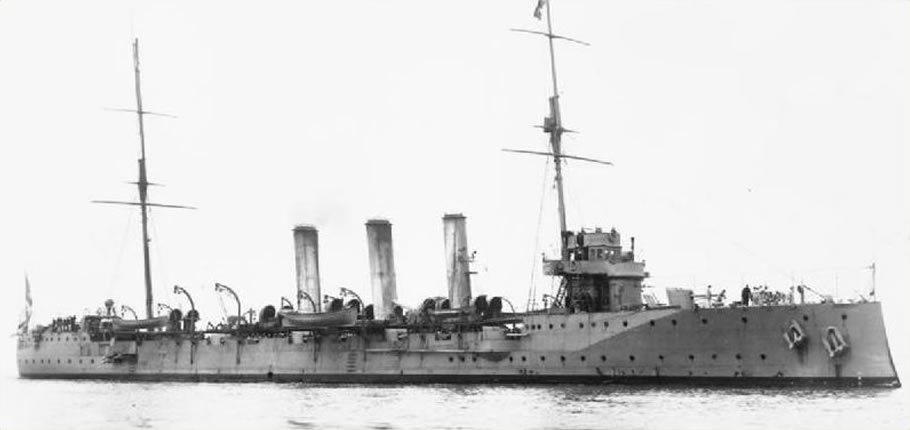
Cruisers – World War 1
After the outbreak of the First World War, a priority for the Royal Navy was to secure the approaches to the English Channel, to prevent elements of the German High Seas Fleet from breaking out into the Atlantic, or from interfering with British maritime trade and convoys to the continent. Most of the major fleet units of the Grand Fleet had dispersed to the navy’s anchorage at Scapa Flow or to other North Eastern ports to monitor the northern route from the North Sea into the Atlantic. Consequently, a number of patrol flotillas were organised along the south and east coasts of England, with commands established at several of the major ports in the region.
A large number of destroyers, flotilla leaders and light cruisers were centred at Harwich, under the command of Commodore Reginald Tyrwhitt.
Cruisers were usually armed with torpedo tubes, and often are fitted with facilities for carrying one to three floatplanes. They usually had a top speed of around 30 knots, were designed to mix speed with range, endurance and firepower, and were expected to be able to out-run any ship they can’t out-fight.
HMS Aboukir
- Type. Cruiser
- Class. Cressy
- Pennant. N00
- Builder. Fairfield
- Ordered. 1897-98
- Laid Down. 09/11/1898
- Launched. 16/05/1900
- Commissioned. 1900
- Speed. 21 knots
- Fate. Sank 22/09/1914
HMS Aboukir was a Cressy-class armoured cruiser laid down by Fairfield Shipbuilding at their shipyard in Govan, Scotland on 9 November 1898 and launched on 16 May 1900. Upon completion she was assigned to the Mediterranean Fleet and spent most of her career there. Upon returning home in 1912, she was placed in reserve. Recommissioned at the start of World War I, she played a minor role in the Battle of Heligoland Bight a few weeks after the beginning of the war. The squadron was tasked with patrolling the Broad Fourteens of the North Sea in support of a force of destroyers and submarines based at Harwich which protected the eastern end of the English Channel from German warships attempting to attack the supply route between England and France.
Aboukir was sunk by the German submarine U-9, together with two of her sister ships, on 22 September 1914. 527 men were killed in the attack
HMS Active
- Type. Cruiser
- Class. Active
- Pennant. A2, 01, N6
- Builder. Pembroke Dockyard
- Ordered. 1910
- Laid Down. 27/07/1910
- Launched. 14/03/1911
- Commissioned. 1911
- Speed. 25 knots
- Fate. Scrapped 21/05/1920

HMS Active
HMS Active was a Active class scout cruiser of the Royal Navy. She was built at Pembroke Dockyard and launched on 14 March 1911. On commissioning, Active was assigned as leader of the 2nd Destroyer Flotilla with the Harwich Force, defending the eastern approaches to the English Channel. In 1915 she was reassigned to the Grand Fleet, and on 31 May-1 June 1916 she took part in the Battle of Jutland. She survived the battle and later that year was assigned as leader of the 4th Destroyer Flotilla at Portsmouth. In 1917 she was at Queenstown and later that year was deployed in the Mediterranean. She survived the First World War and was sold for scrapping on 21 May 1920.
HMS Adventure
- Type. Cruiser
- Class. Adventure
- Pennant. D10, P64, P01
- Builder. Armstrong Whitworth
- Ordered. 1903
- Laid Down. 07/01/1904
- Launched. 08/09/1904
- Commissioned. 1905
- Speed. 25 knots
- Fate. Scrapped 03/03/1920
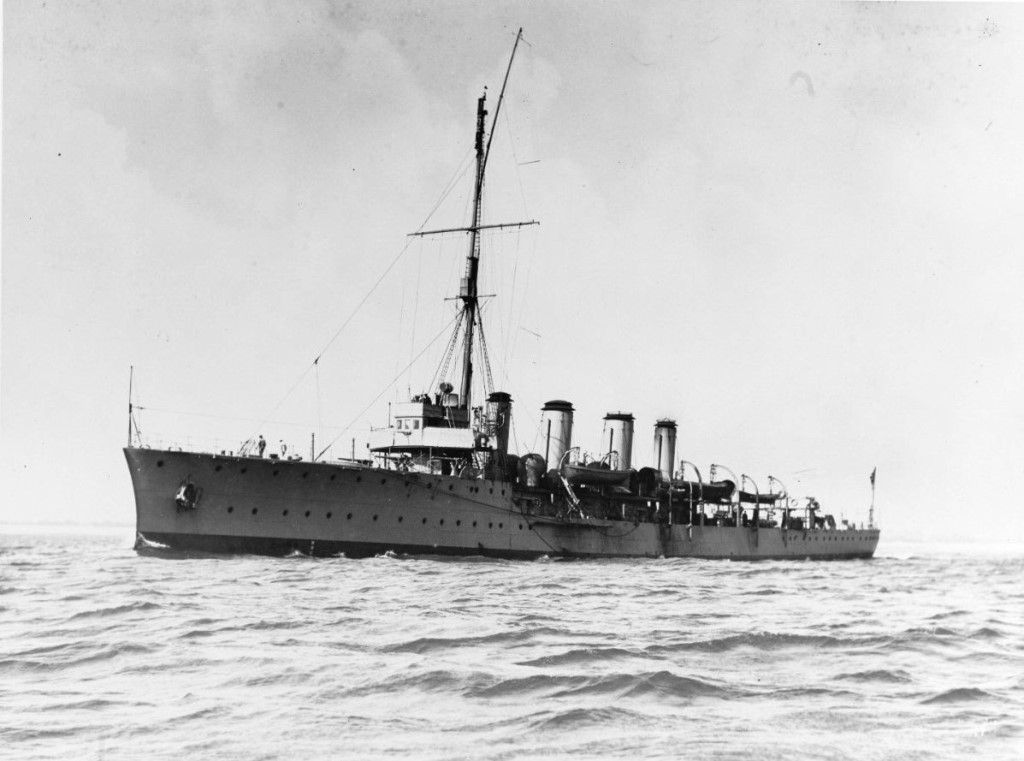
HMS Adventure
HMS Adventure was an Adventure class scout cruiser which served with the Royal Navy before and during the War. Built by Armstrong Whitworth of Elswick, Tyne and Wear, launched on 8 September 1904. She escorted convoys to Gibraltar during the last summer of the war. She returned to Immingham docks to be paid off on 12 August 1919. Her bad luck with collisions continued when she was rammed by a trawler on the Humber in January 1920. She was then sold to the breakers for scrap on 3 March 1920.
HMS Amethyst
- Type. Cruiser
- Class. Topaz
- Pennant. P00, P02
- Builder. Armstrong Whitworth
- Ordered. 1902
- Laid Down. 1903
- Launched. 05/11/1903
- Commissioned. 1904
- Speed. 22.5 knots
- Fate. Scrapped 1920
HMS Amethyst was a third-class protected cruiser of the Topaz class. She was launched on the 5 November 1903 by Armstrong, Elswick, served during World War I at the Dardanelles and Gallipoli, in the Mediterranean and the South Atlantic. Once World War I broke out in 1914, HMS Amethyst was assigned to the Harwich force of the Royal Navy. She participated in the Battle of Heligoland Blight under the command of Commodore Reginald Tyrwhitt. Later that year she was transferred to the 1st Light Cruiser Squadron of the Royal Navy. On 14 March at 04:10 she was hit by field artillery and lost 22 men killed. A further 38 men were wounded, of whom 4 later died. Amethyst retired to Tenedos for repairs.
Amethyst was paid off for the last time on 10 February 1919 at Malta and was sold for scrap on 1 October 1920.
HMS Amphion
- Type. Cruiser
- Class. Active
- Pennant. N/A
- Builder. Pembroke Dock
- Ordered. 1910
- Laid Down. 15/03/1911
- Launched. 14/12/1911
- Commissioned. 1913
- Speed. 25 knots
- Fate. Sank 06/08/1914
-
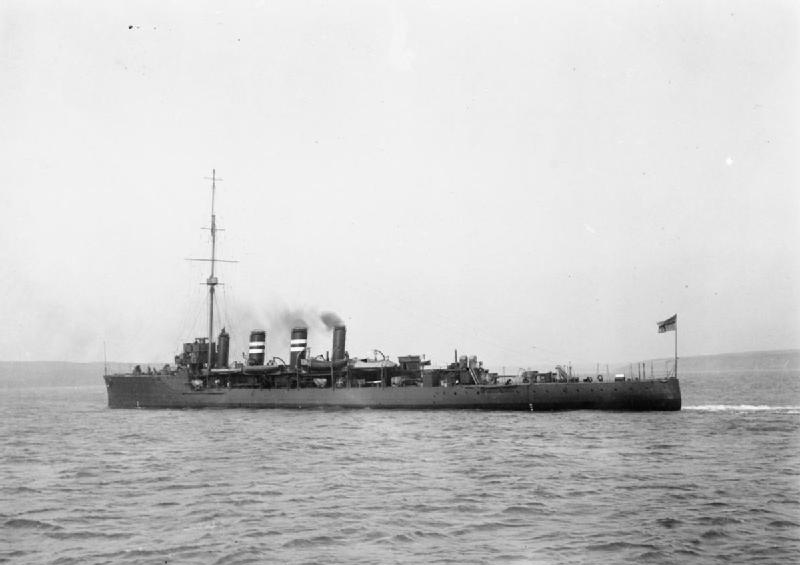
HMS Amphion
HMS Amphion was an Active-class scout cruiser of the Royal Navy. Built at Pembroke Dockyard and launched on 14 December 1911. She became the first ship of the Royal Navy to be sunk in the First World War. On commissioning, Amphion was assigned as leader of the 3rd Destroyer Flotilla with the Harwich Force, defending the eastern approaches to the English Channel. On the night of 4 August, she had departed Emden and headed into the North Sea to lay mines off the Thames Estuary. Königin Luise was disguised in the black, buff, and yellow colours of the steamers of the Great Eastern Railway, lee from the approaching fleet aroused suspicions and four destroyers gave chase, including Lance and Landrail. In about an hour’s time, Königin Luise was chased down and sunk, with 46 survivors from the crew of 100. The escorting destroyers closed in and took off Amphion’s crew and the few rescued German survivors. Though her engines were stopped, her momentum carried her back into the minefield and at 07:03, just three minutes after the last boatload of survivors were taken off, she again struck the same row of mines. The fore magazine exploded, with debris striking the rescue boats and destroyers. One of Amphion’s shells burst on the deck of Lark, killing two of Amphion’s men and a German prisoner rescued from the cruiser. Amphion then rapidly sank within 15 minutes of the explosion. Around 150 British sailors were killed in the sinking, as well as 18 of the crew rescued from Königin Luise.
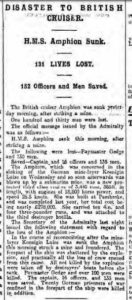
HMS Amphion 07/08/1914
Survivors of the British cruiser Amphion have been able to supply further interesting details of the circumstances in which this ship sank with about half her crew. Her officers had no idea that they were in the neighbourhood of a minefield. Stokers down below were lustily singing Rule Britannia” as they fed the furnaces. The conjecture is that the Amphion struck a cable about in its Centre, which connected two of the contact mines. The ship was proceeding at a fair speed at the time, and her momentum dragged the two ex- plosive weapons sharply to her side abaft the forward bulkhead. If she had been struck further forward she would probably have been able to get back into Harwich Harbour injured, but not seriously so. The explosions caused vital injuries, and apparently started the magazines. Considering the extent and character of the damage the length of time which the Amphion remained afloat bears strong testimony to the skill of her designers, the excellence of the material and the splendid workmanship put into her at Pembroke Dock, where she was built. Under the most deadly blow she remained afloat a sufficient length of time for over half her crew to seek safety.
The official press bureau on Wednesday afternoon issued the following:-
“3.30pm – at 9am on August 5th, HMS Amphion with the 3rd flotilla proceeded to carry out a certain pre-arranged plan of search and about an hour later a trawler informed them that she had seen a suspicious ship ‘throwing things overboard’ in an indicated position. Shortly afterwards the mine layer Königin Luise was sighted steering east. Four destroyers gave chase and in about an hour’s time she was rounded up and sunk. After picking up survivors the search continued without incident till 3.30am when the Amphion was on the return course.
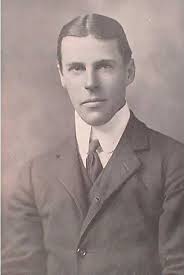
Captain. Fox
At 6.30 am Amphion struck a mine. A sheet of flame instantly enveloped the bridge which rendered the Captain insensible and he fell on the fore and aft bridge. As soon as he recovered consciousness he ran to the engine room to stop the engines, which were still going at revolutions for 20 knots. As all the forepart was on fire, it proved impossible to reach the bridge or to flood the fore magazine. The ship’s back appeared to be broken and she was already settling by the bows.All efforts were therefore directed to placing the wounded in a place of safety in case of explosion and towards getting her a tow by the stern. By the time destroyers closed in it was clearly time to abandon ship. The men fell in with composure and 20 minutes after the mine struck, the men, officers and captain left their ship.Three minutes later it exploded. Debris falling from a great height struck the rescue boats, destroyers and one of the Amphion’s shells burst on the deck of one of the latter killing two of the men and a German prisoner rescued from the cruiser. After 15 minutes the Amphion had disappeared.
Captain Fox speaks in the highest terms of the behavior of the men throughout.”
HMS Arethusa
-
Type. Cruiser
-
Class. Arethusa
-
Pennant. 3C
-
Builder. Chatham Dockyard
-
Ordered. 1912
-
Laid Down. 28/10/1912
-
Launched. 25/10/1913
-
Commissioned. 1914
-
Speed. 28.5 Knots
-
Fate. Sank 11/02/1916
HMS Arethusa was of the Arethusa class of light cruisers. She was laid down at Chatham Dockyard in October 1912, launched on 25 October 1913, and commissioned in August 1914 as flotilla leader for the Harwich Force, She went on to see a considerable amount of action during the First World War. On 28 August 1914 she fought at the Battle of Heligoland Bight, flying the flag of Commodore Reginald Tyrwhitt. She was seriously damaged by the German cruisers SMS Frauenlob and SMS Stettin and had to be towed home. On 25 December of that year, Arethusa took part in the Cuxhaven Raid and on 24 January 1915 she fought at the Battle of Dogger Bank (1915). Later in the same year she was transferred to the 5th Light Cruiser squadron of the Harwich force. In September 1915 she captured four German trawlers.
On 11 February 1916 she struck a mine off Felixstowe claimed to have been laid by UC-7, drifted ashore before she could be rescued and broke her back. In the explosion 6 crew members lost their lives.
HMS Attentive
- Type. Cruiser
- Class. Adventure
- Pennant. P03, P06
- Builder. Armstrong Whitworth
- Ordered. 1903
- Laid Down. 1904
- Launched. 20/11/1904
- Commissioned. 1905
- Speed. 25 knots
- Fate. Scrapped 12/04/1920
-
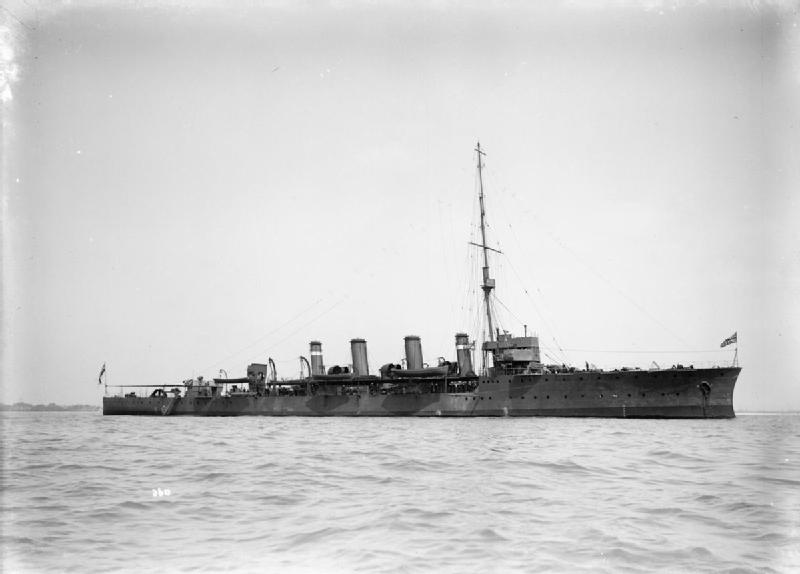
HMS Attentive
HMS Attentive was an Adventure Class Cruiser launched on the 20th November 1904 On the afternoon of the 27th April 1908, the eastern destroyer Flotilla, consisting of 15 vessels, in company with the scouts HMS Adventure and HMS Attentive, left Harwich for the purpose of firing exercise and night, manoeuvres. a little after midnight all the vessels having their lights masked, HMS Gala one of the destroyers came into collision with HMS Attentive being struck by the latter’s ram in the after part of the engine room and cut in two. Attentive was paid off in December 1918, after hostilities ended, and was sold for scrapping on 12 April 1920.
HMS Aurora
- Type. Cruiser
- Class. Arethusa
- Pennant. C1, 08
- Builder. Devonport
- Ordered. 1912
- Laid Down. 24/10/1912
- Launched. 30/09/1913
- Commissioned. 1914
- Speed. 28.5 knots
- Fate. Scrapped 1927
-

HMS Aurora
HMS Aurora was an Arethusa-class light cruiser launched on 30 September 1913 at Devonport Dockyard. Aurora was assigned as leader of the 10th Destroyer flotilla of the Harwich Force, guarding the eastern approaches to the English Channel. In August 1915 she took part in sinking of the German raider Meteor. In 1918 she was again reassigned, to the 7th Light Cruiser Squadron of the Grand Fleet and HMS Aurora was one of the ships present at the surrender of the German High Seas Fleet, in November 1918. Between 1918 and 1920, HMS Aurora was decommissioned to relieve financial pressures of the Home Fleet by the Admiralty. Her manning was reduced to a custodian crew and the relieved personnel were sent to other units.
In 1920 she was re-activated to outfit her for transfer to the Royal Canadian Navy. The RCN took possession of her on 1 November 1920 and renamed her HMCS Aurora. She sailed shortly afterwards from the United Kingdom for Halifax, Nova Scotia, arriving on 21 December with two ex-Royal Navy destroyers that had also been transferred to the RCN.
After a minimal time in port at HMC Dockyard, the three ships set out for a training cruise via the Caribbean to Esquimalt, British Columbia. HMCS Aurora returned to Halifax on 30 July 1921 via the same route.
In August 1921, drastic budget cuts resulted in the decommissioning of HMCS Aurora. She was immediately Paid Off, and in 1922 she was disarmed. Her weapons were placed ashore in training facilities and on other active ships. Her crew was reduced to non-manned; much of her up-to-date equipment was salvaged for use in other RCN warships. The Aurora’s hulk was left alongside a jetty at the RCN base in Halifax until 1927 when her deterioration resulted in city officials demanding the RCN move her. The RCN immediately sold her for scrap, and she was broken up.
HMS Blenheim
- Type. Cruiser
- Class. Blake
- Pennant.
- Builder. Thames Ironworks
- Ordered.
- Laid Down. 1888
- Launched. 05/07/1890
- Commissioned. 1891
- Speed. 22 knots
- Fate. Scrapped 13/07/1926
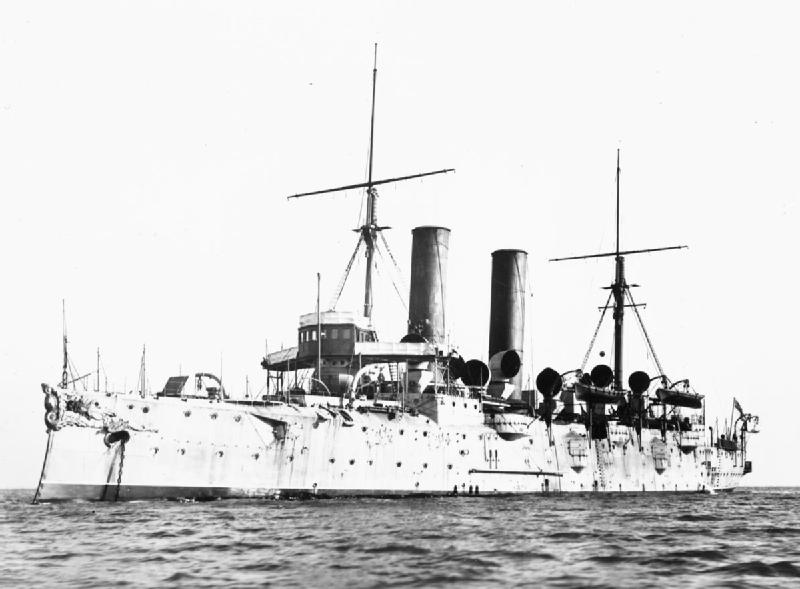
HMS Blenheim
HMS Blenheim was a Blake class first class protected cruiser that served in the Royal Navy from 1890–1926. She was built by Thames Ironworks & Shipbuilding Company at Leamouth, She served as a cruiser with the Channel Squadron until May 1908 when she joined the Mediterranean Fleet as a destroyer depot ship. She was sent to Mudros in March 1915 in support of the Mediterranean Expeditionary Force at the Battle of Gallipoli. She served as a depot ship for the Beagles of the Third Destroyer Flotilla in the Mediterranean through much of the war.
She Recommissioned at Malta on 28 June, 1919 and scrapped in 1926 at Pembroke Dock.
HMS Cambrian
- Type. Light Cruiser
- Class. Cambrian
- Pennant. A3, 25, 30
- Builder. Devonport
- Ordered. 1913
- Laid Down. 08/12/1914
- Launched. 03/03/1916
- Commissioned. 1916
- Speed. 28.5 knots
- Fate. Scrapped 1934
-
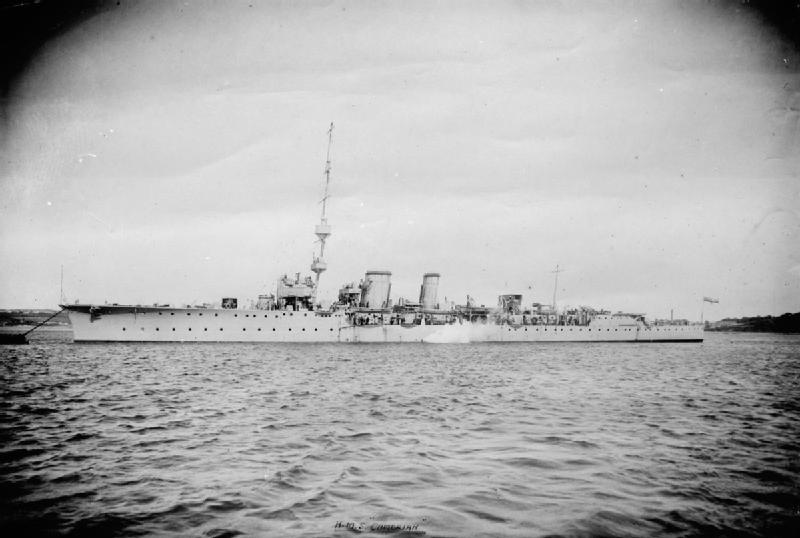
HMS Cambrian
HMS Cambrian was a C-class light cruiser, Built by Pembroke Dockyard in Pembroke Dock, Wales, Cambrian was laid down on 8 December 1914, launched on 3 March 1916, and completed in May 1916. 19 September 1911. Became flagship in 1913 and returned home to pay off early in 1914 and put on sale list, but reinstated in August 1914. Fitted out as Stokers’ TS at Devonport and renamed Harlech on completion in March 1916. HMS Cambrian served with the Grand Fleet during the First World War, forming part of the 4th Light Cruiser Squadron from the time she came into service until the end of the war. She just missed the battle of Jutland, but all three of her sisters took part in the battle. In June 1924, Cambrian was decommissioned and placed under dockyard control for a refit that lasted into 1926, when she was recommissioned to serve in the 2nd Light Cruiser Squadron until 1929. After transporting troops to China in 1929, she was decommissioned in November 1929 and entered the Nore Reserve. She was recommissioned as the flagship of the Nore Reserve in March 1931, then was decommissioned in July 1933 and placed under dockyard control at Sheerness.
Cambrian was sold on 28 July 1934 to Metal Industries of Rosyth, Scotland, to be scrapped.
HMS Canterbury
- Type. Cruiser
- Class. Cambrian
- Pennant. 0A, 27,59
- Builder. John Brown
- Ordered. 1913
- Laid Down. 14/10/1914
- Launched. 21/12/1915
- Commissioned. 1916
- Speed. 28.5 knots
- Fate. Scrapped 1934
-

HMS Canterbury
HMS Canterbury was a Cambrian class light cruiser of the Royal Navy that saw service in the First World War and the Russian Civil War. She was part of the Cambrian group of the C class. Canterbury was laid down on 28 October 1914, launched on 21 December 1915, and completed in May 1916. From 1916 to 1918, she was assigned to the 5th Light Cruiser Squadron, operating as part of Harwich Force in the North Sea to defend the eastern approaches to the Strait of Dover and English Channel. On 5 June 1917, she and the light cruisers HMS Centaur and HMS Conquest sank the German torpedo boat S 20 in the North Sea near the Shouwen Bank off Zeebrugge, Belgium. In 1918 she was assigned to operate in the Aegean Sea, where she served out the rest of the war.
After the First World War, Canterbury served in the Black Sea in 1919 during the British intervention in the Russian Civil War. She commissioned at Portsmouth in November 1919 for service in the 1st Light Cruiser Squadron in the Atlantic Fleet. She was attached to the Gunnery School at Portsmouth from 1920 to 1922, and then was in the Portsmouth Reserve from 1922 to 1924. She Recommissioned at Portsmouth in May 1924 to serve in the 2nd Cruiser Squadron in the Atlantic Fleet, and then began a refit in June 1925.
Canterbury Recommissioned out of the Nore Reserve in November 1926 for another tour of duty in the Atlantic Fleet with the 2nd Cruiser Squadron. She was decommissioned in December 1933.
HMS Cardiff
- Type. Cruiser
- Class. Ceres
- Pennant. D58, 29, 39
- Builder. Fairfield
- Ordered. 1916
- Laid Down. 22/07/1916
- Launched. 12/04/1917
- Commissioned. 1917
- Speed. 29 knots
- Fate. Scrapped 08/03/1946
-
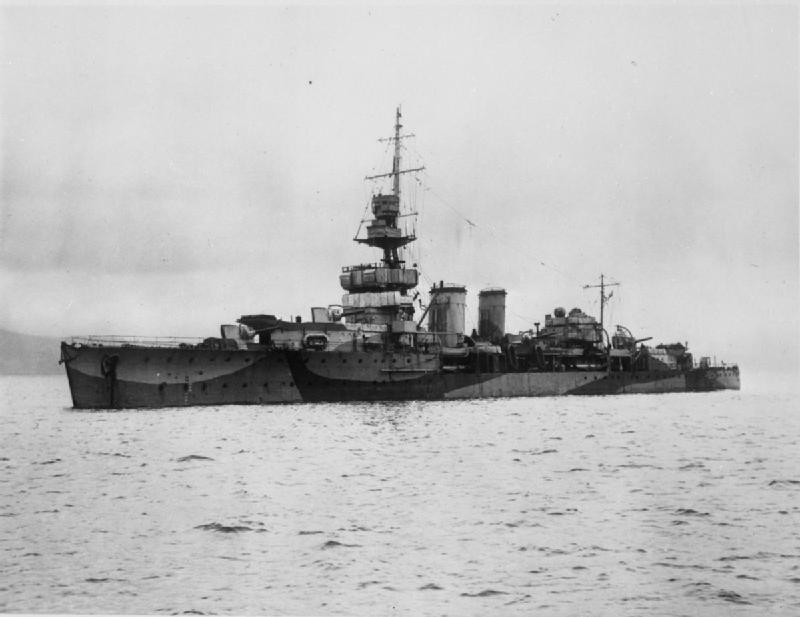
HMS Cardiff
HMS Cardiff was a Ceres Class Cruiser launched on the 12th April 1917 by Fairfield Shipbuilding & Engineering Company. She was commissioned in 1917, becoming flagship of the 6th Light Cruiser Squadron, part of the Grand Fleet in July 1917. In 1918, the war had come to a close, and Cardiff had the honour of leading the German High Seas Fleet to the River Forth.The German ships were to be interned under the terms of the armistice, but remained under German command.
The German Fleet was later scuttled under the orders of its commanding officer, Admiral Ludwig von Reuter to ensure they did not fall into the hands of the victors. In November 1921 she escorted the Austro-Hungarian Imperial-Royal couple to Madeira. Though World War I was over, her service was not. She deployed to the Baltic Sea, operating near Reval (Tallinn), Estonia against the Bolsheviks in operations that also involved Allied ground troops.
Between the wars Cardiff, now obsolescent, served overseas; in the early 1930s, she was the flagship of the Navy’s Africa Station. Cardiff survived to see yet another war, though she would not see action. After a brief period escorting convoys, in which she was involved in the pursuit of the German battleships Scharnhorst and Gneisenau after the sinking of HMS Rawalpindi. She was then converted for use as a training ship. She was sold on 23 January 1946, and broken up at the yards of Arnott Young, Dalmuir, Scotland from 18 March 1946.
HMS Carlisle
-
- Type. Light Cruiser
- Class. Cairo
- Pennant. D67, 41
- Builder. Fairfield
- Ordered. 1916
- Laid Down. 02/10/1917
- Launched. 09/07/1918
- Commissioned. 11/11/1918
- Speed. 29 knots
- Fate. Scrapped 1949

HMS Carlisle
HMS Carlisle was a C-class light cruiser of the Royal Navy, group of the C-class of cruisers. Carlisle. She was laid down by Fairfield Shipbuilding and Engineering Company in 1917, and launched on 9 July 1918. Carlisle was commissioned too late to see action in the First World War, and in 1919 Carlisle joined the 5th Light Cruiser Squadron at Harwich. During March she left Harwich in company with the squadron, and took up station in China. In July 1943, she provided escort for the support force for the Allied landings in Sicily. During September-October, during the German counterattack in the Aegean Sea, Carlisle made a sortie into the area south of Piraeus with the destroyers HMS Panther and HMS Rockwood in order to intercept German convoys in the Scarpanto Strait. On 9 October 1943 they were spotted by German Ju 87 dive bombers from I. StG 3 of Megara Air Base which succeeded in sinking HMS Panther at 12.05 hrs and later on seriously damaged Carlisle. She was taken in tow to Alexandria by Rockwood. She was considered to be beyond economical repair as a warship, and instead was converted to serve as a base ship in the harbour of Alexandria in March 1944. She was last listed as a hulk in 1948 after the war had ended, and was broken up in 1949.
HMS Caroline
- Type. Light Cruiser
- Class. Caroline
- Pennant. 87, 30, 44
- Builder. Cammell Laird
- Ordered. 1913
- Laid Down. 28/01/1914
- Launched. 29/09/1914
- Commissioned. 04/12/1914
- Speed. 28.5 knots
- Fate. Preserved
-
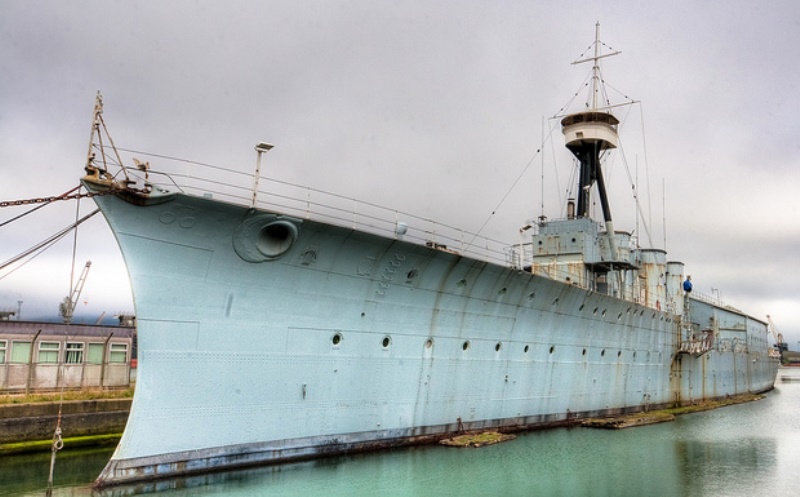
HMS Caroline
HMS Caroline was a Caroline Class Light Cruiser launched on the 29th September 1914 by Cammell Laird. She served in the North Sea throughout the First World War. She spent much of the war with the 4th Light Cruiser Squadron: Caroline fought with the squadron in 1916 in the Battle of Jutland, under the command of Captain H. R. Crooke. Caroline later served on the East Indies Station before being placed in Reserve and converted to a headquarters and training ship for the Royal Naval Volunteer Reserve’s Ulster Division in 1924.
After the Second World War, the Royal Navy returned Caroline to the Royal Naval Volunteer Reserve, and she served as its last afloat training establishment. She underwent a refit at Harland and Wolff in Belfast in 1951.
Caroline was decommissioned on 31 March 2011 in a traditional ceremony. Her ensign was laid up in St Anne’s Cathedral in Belfast she is listed as part of the National Historic Fleet, Core Collection. On her decommissioning, she was placed into the care of the National Museum of the Royal Navy at Portsmouth, though remaining moored in her position in Alexandra Dock in Belfast.
HMS Carysfort
- Type. Light Cruiser
- Class. Caroline
- Pennant. 88, 31, 22
- Builder. Pembroke Dockyard
- Ordered. 1913
- Laid Down. 25/2/1914
- Launched. 14/11/1914
- Commissioned. 1915
- Speed. 28.5 knots
- Fate. Scrapped 1931
-
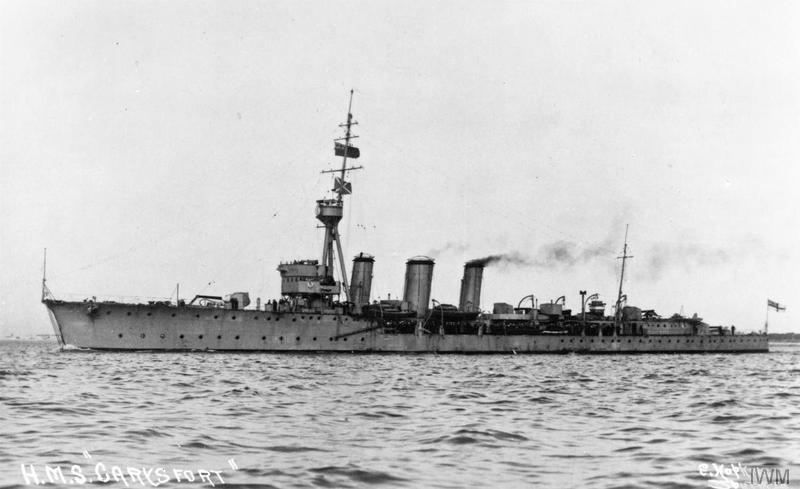
HMS Carysfort
HMS Carysfort was a Caroline class light cruiser that saw service in World War I and the Russian Civil War. Constructed by either Pembroke Dockyard in Pembroke Dock, Wales, or Hawthorn Leslie and Company at Tyneside, England , Carysfort was laid down on 25 February 1914, launched on 14 November 1914, and completed in June 1915. In April 1919, Carysfort was reassigned to the 2nd Light Cruiser Squadron in Harwich Force, and that year was sent to the Baltic Sea to take part in the British campaign there against Bolshevik and German forces during the Russian Civil War. She returned to the United Kingdom in 1920, and became a unit of the Atlantic Fleet in April 1921.
Carysfort was sold in August 1931 for scrapping and arrived at the yards of McLellan in October 1931 to be broken up.
HMS Centaur
- Type. Light Cruiser
- Class. Centaur
- Pennant. 36, 34, 10
- Builder. Vickers
- Laid Down. 1915
- Launched. 01/01/1916
- Commissioned. 1916
- Speed. 28.5 knots
- Fate. Scrapped 1934
-
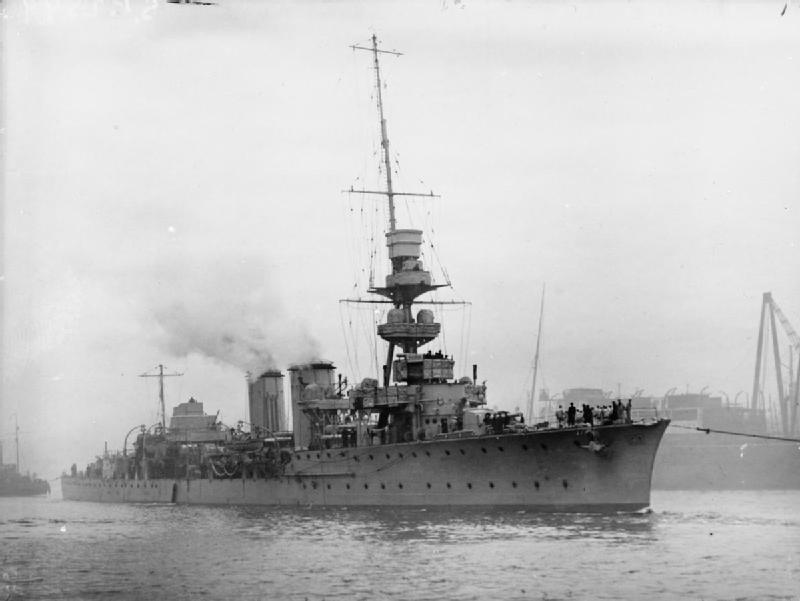
HMS Centaur
HMS Centaur was a C-class light cruiser that served in the First World War and the Russian Civil War. Built by Vickers Limited, Centaur was laid down in January 1915 and launched on 1 January 1916. Upon being commissioned into the Royal Navy in August 1916, Centaur was assigned to the 5th Light Cruiser Squadron, which operated as a part of Harwich Force in the North Sea to defend the eastern approaches to the Strait of Dover and English Channel. On 5 June 1917 she and the light cruisers HMS Canterbury and HMS Conquest sank the German torpedo boat S20 in the North Sea near the Schouwen Bank off Zeebrugge, Belgium. On 13 June 1918 she struck a mine and had to undergo repairs at Hull. After the First World War, Centaur was sent to the Baltic Sea in December 1918 to take part in the British campaign there against Bolshevik and German forces during the Russian Civil War. In March 1919, she was reassigned from Harwich Force to the 3rd Light Cruiser Squadron in the Mediterranean Fleet, recommissioning at Malta in June 1920 and Gibraltar in October 1922 to continue that service.
Centaur was placed on the sale list in 1933 and sold in February 1934 to King, of Troon, Scotland, for scrapping. She arrived at their yards on 6 March 1934 to be scrapped.
HMS Cleopatra
- Type. Light Cruiser
- Class. Caroline
- Pennant. 1A, 40, 88
- Builder. Devonport Dockyard
- Ordered. 1913
- Laid Down. 26/02/1914
- Launched. 14/01/1915
- Commissioned. 1915
- Speed. 28.5 knots
- Fate. Scrapped 1931
-
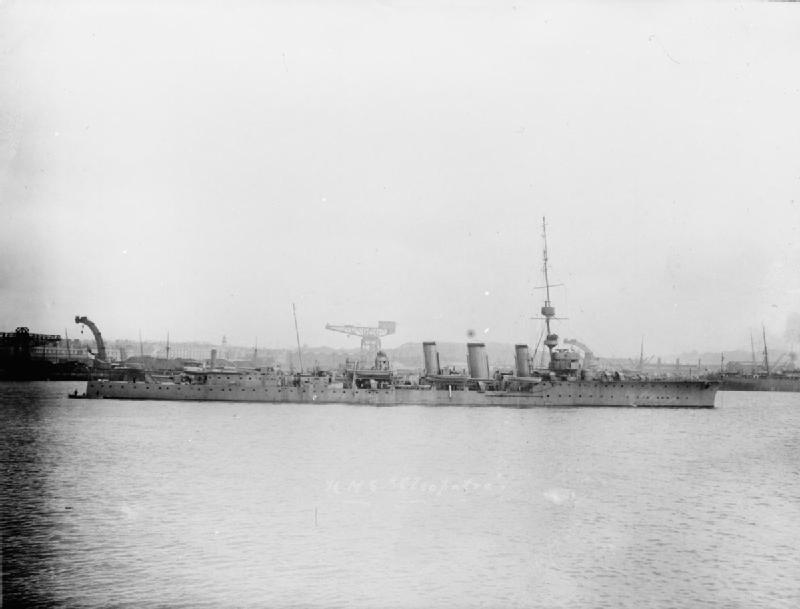
HMS Cleopatra
HMS Cleopatra was a C-class light cruiser , part of the Caroline group of the C class. Constructed by Devonport Dockyard, Cleopatra was laid down on 26 February 1914, launched on 14 January 1915, and completed in June 1915. Commissioned into service in the Royal Navy in June 1915, Cleopatra was assigned to the 5th Light Cruiser Squadron in Harwich Force, which operated in the North Sea to guard the eastern approaches to the Strait of Dover and English Channel. She underwent modernisation during 1917, and in October 1917 joined the other Harwich Force cruisers in a patrol zone to intercept any German attempt to intercept convoys steaming to and from Scandinavia. She was assigned to the 7th Light Cruiser Squadron of the Grand Fleet in August 1918 as squadron flagship, and served in that capacity through the end of World War I in November 1918 and until March 1919.
In March 1931, she was decommissioned and placed under dockyard control at Chatham Dockyard. Cleopatra was sold on 26 June 1931 to Blyth, Northumberland, for scrapping.
HMS Conquest
- Type. Light Cruiser
- Class. Caroline
- Pennant. C0, 48, 37
- Builder. Chatham Dockyard
- Ordered. 1913
- Laid Down. 03/03/1914
- Launched. 20/01/1915
- Commissioned. 1915
- Speed. 28.5 knots
- Fate. Scrapped 29/08/1930
-
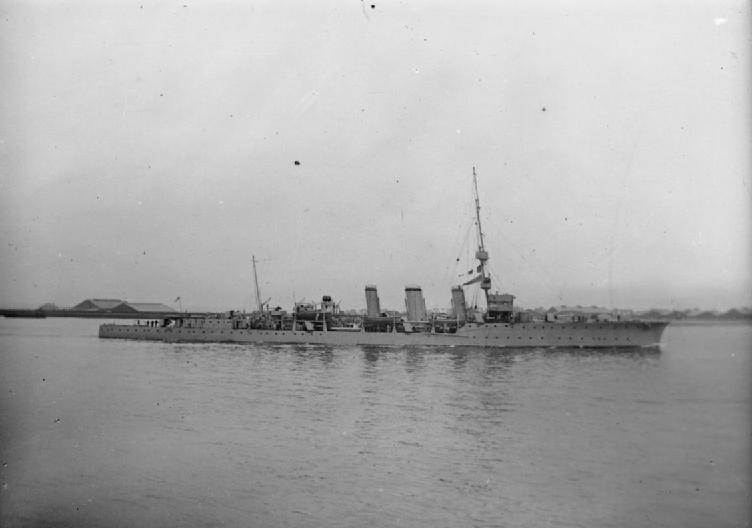
HMS Conquest
HMS Conquest was a Light Cruiser launched on the 20th January 1915 and commissioned into the 5th Light Cruiser Squadron of the Harwich Force in June 1915. There she took part in the hunt for the German mine layer Meteor of August 1915 and also accompanied British mine layers. She also accompanied the force that attacked the German Zeppelin base at Tondern in March 1916. On 25 April 1916 the Germans attacked Lowestoft. Tyrwhitt, with the Harwich cruisers, intercepted the German force, which included their battle-cruisers, before they reached the coast, but was unable to lure them away. After the attack on the town, the German battle cruisers moved towards Yarmouth. Tyrwhitt attacked their light cruisers, forces the battle cruisers to turn back. When they appeared, Tyrwhitt was forced to flee back south. His squadron was under fire for 13 minutes, before the Germans ended the engagement and turned east for home. HMS Conquest was hit by a 12in salvo, which killed 25, wounded 13 and destroyed her aerials. However, she was still able to make 20kts, and escaped further damage.
Conquest was sold on 29 August 1930 to Metal Industries of Rosyth, Scotland, for scrapping. While in the North Sea bound for the ship breaker’s yard under tow off Flamborough Head in bad weather on 26 September 1930 with a skeleton crew of six men on board, her tow line broke, and she was adrift and missing until 28 September 1930, when she was found and her tow to Rosyth resumed.
HMS Concord
- Type. Light Cruiser
- Class. C
- Pennant. 2a, 46, 15
- Builder. Vickers
- Ordered. 1914
- Laid Down. 1915
- Launched. 01/04/1916
- Commissioned. 1916
- Speed. 28.5 knots
- Fate. Scrapped 16/09/1935
-

HMS Concord
HMS Concord was a C-class light cruiser that saw service during the First World War. She was launched on the 1st of April 1916. Upon being commissioned into the Royal Navy in December 1916, Concord was assigned to the 5th Light Cruiser Squadron, which operated as part of Harwich Force in the North Sea to defend the eastern approaches to the Strait of Dover and English Channel. She remained in the squadron through the end of the war in November 1918 and until March 1919. Concord was placed on the sale list in November 1934 and was sold in August 1935 for scrapping. She arrived at the yards of Metal Industries of Rosyth, Scotland, on 16 September 1935 to be broken up.
HMS Coventry
- Type. Light Cruiser
- Class. C
- Pennant. D43, 4C, 61
- Builder. Swan Hunter
- Laid Down. 04/08/1916
- Launched. 06/07/1917
- Commissioned. 21/02/1918
- Speed. 29 knots
- Fate. Scuttled 14/09/1942
-
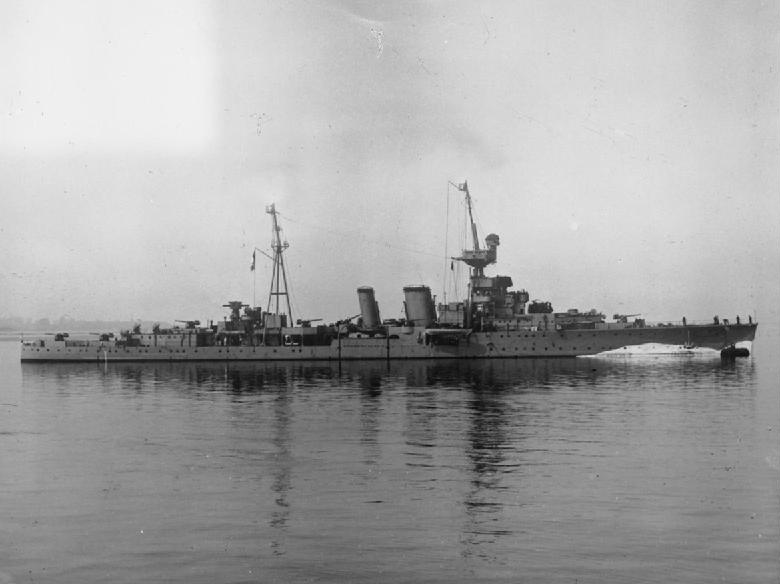
HMS Coventry
HMS Coventry was a C-class light cruiser of the Royal Navy, She was part of the Ceres group of the C-class of cruisers. She was laid down on 4 August 1916, launched 6 July 1917 and completed for naval service in February 1918. HMS Coventry was in the 5th Light Cruiser squadron from February 1918 till May 1919, and served in the Baltic in this time. Commissioned with the pennant (D43) in May 1919 she was accepted into the Atlantic fleet, until in 1920 when HMS Coventry became the HQ ship for naval Inter allied Disarmament Commission. She went into refit in late 1920 and once the refit was completed she joined the 2nd Light cruiser squadron and she became flagship to the Rear admiral Atlantic Fleet, Andrew Cunningham. A Torpedo explosion while in Malta in March 1923 caused the death of two of her crew. At the outbreak of World War II HMS Coventry was serving with the Home Fleet between 1939 and 1940, and was damaged on 1 January 1940 in a German air attack on the Shetland Islands, north of Scotland. She was assigned to the Mediterranean fleet in 1940, and was torpedoed and damaged by the Italian submarine Neghelli in the eastern Mediterranean. Coventry also participated in the Battle of Cape Spartivento.
HMS Coventry was heavily damaged in the Eastern Mediterranean, north-west of Alexandria, Egypt by German Ju 87 dive-bombers on 14 September 1942, whilst participating in Operation Agreement. The ship was on fire and had to be scuttled by HMS Zulu.
HMS Cressy
- Type. Cruiser
- Class. Cressy
- Pennant. N40
- Builder. Fairfield
- Ordered.
- Laid Down. 12/10/1898
- Launched. 04/12/1899
- Commissioned. 1900
- Speed. 21 knots
- Fate. Sunk 22/09/1914
-
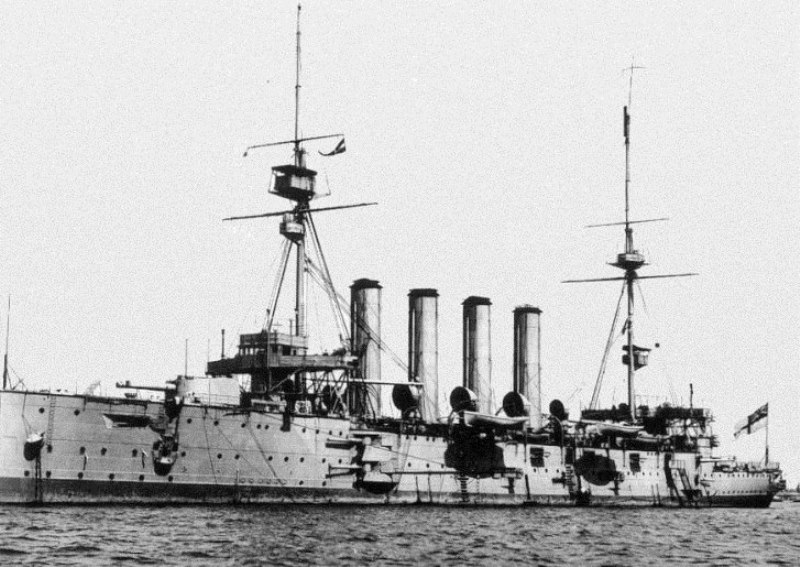
HMS Cressy
HMS Cressy was a Cressy-class armoured cruiser built by Fairfield Shipbuilding at their shipyard in Govan, Scotland on 12 October 1898 and launched on the 4th December 1899. The ship was assigned to the 7th Cruiser Squadron shortly after the outbreak of World War I in August 1914. The squadron was tasked with patrolling the Broad Fourteens of the North Sea in support of a force of destroyers and submarines based at Harwich which protected the eastern end of the English Channel from German warships attempting to attack the supply route between England and France. During the Battle of Heligoland Bight on 28 August, the ship was part of Cruiser Force ‘C’, in reserve off the Dutch coast, and saw no action. After the battle, Rear Admiral Arthur Christian ordered Cressy to take aboard 165 unwounded German survivors from the badly damaged ships of Commodore Reginald Tyrwhitt’s Harwich Force. Escorted by her sister Bacchante, she set sail for the Nore to unload their prisoners.
On the morning of 22 September, Cressy and her sisters, Aboukir and Hogue, were on patrol without any escorting destroyers as these had been forced to seek shelter from bad weather. The three sisters were steaming in line abreast about 2,000 yards apart at a speed of 10 knots. They were not expecting submarine attack, but had lookouts posted and one gun manned on each side to attack any submarines sighted. The weather had moderated earlier that morning and Tyrwhitt was en route to reinforce the cruisers with eight destroyers.
U-9, commanded by Kapitänleutnant Otto Weddigen, had been ordered to attack British transports at Ostend, but had been forced to dive and take shelter from the storm. On surfacing, she spotted the British ships and moved to attack. She fired one torpedo at 06:20 at Aboukir which struck her on the starboard side; the ship’s captain thought he had struck a mine and ordered the other two ships to close to transfer his wounded men. Aboukir quickly began listing and capsized around 06:55 despite counter-flooding compartments on the opposite side to right her.
As Hogue approached her sinking sister, her captain, Wilmot Nicholson, realised that it had been a submarine attack and signalled Cressy to look for a periscope although his ship continued to close on Aboukir as her crew threw overboard anything that would float to aid the survivors in the water. Having stopped and lowered all her boats, Hogue was struck by two torpedoes around 06:55. The sudden weight loss of the two torpedoes caused U-9 to broach the surface and Hogue ’s gunners opened fire without effect before the submarine could submerge again. The cruiser capsized about ten minutes after being torpedoed and sank at 07:15.
Cressy attempted to ram the submarine, but did not succeed and resumed her rescue efforts until she too was torpedoed at 07:20. Weddigen had fired two torpedoes from his stern tubes, but only one hit. U-9 had to maneuver to bring her bow around with her last torpedo and fired it at a range of about 550 yards (500 m) at 07:30. The torpedo struck on the port side and ruptured several boilers, scalding the men in the compartment. As her sisters had done, Cressy took on a heavy list and then capsized before sinking at 07:55. Several Dutch ships began rescuing survivors at 08:30 and were joined by British fishing trawlers before Tyrwhitt and his ships arrived at 10:45. From all three ships 837 men were rescued and 62 officers and 1,397 enlisted men lost: 560 of those lost were from Cressy.
In 1954 the British government sold the salvage rights to all three ships to a German company and they were subsequently sold again to a Dutch company which began salvaging the wrecks’ metal in 2011.
HMS Curacoa
- Type. Cruiser
- Class. Ceres
- Pennant. D41, A7, 62
- Builder. Pembroke Dockyard
- Ordered. 1915
- Laid Down. 1916
- Launched. 05/05/1917
- Commissioned. 18.02/1918
- Speed. 29 knots
- Fate. Sank 02/10/1942
-
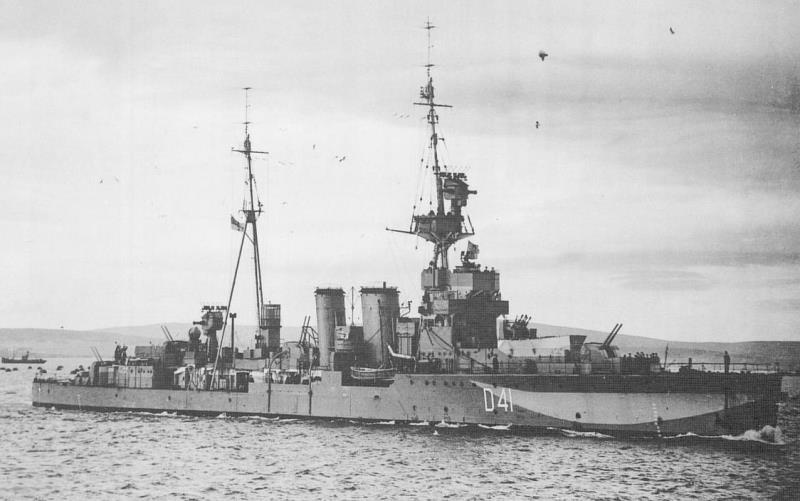
HMS Curacoa
HMS Curacoa was a Ceres group C-class light cruiser. She was launched on the 5th May 1917 by Pembroke Dockyard. Her first service was with the Grand Fleet during the last days of the First World War. HMS Curacoa ended her Baltic deployment as Task Force Flagship, before returning to the UK and being re-deployed to the Med’n, where she remained until 1928. On 2 October 1942 north of the coast of Ireland she was escorting the ocean liner RMS Queen Mary carrying 10,000 American troops of the 29th Infantry Division to join the Allied forces in Europe. Queen Mary was steaming an evasive zig-zagging course; eight minutes to starboard, eight minutes to port then the resumption of her base course for four minutes before starting the cycle again, which the aged Curacoa could not match because of deterioration of her engines. Curacoa was hard pressed to keep pace with Queen Mary as it was and her Captain opted to forego the zig-zag so as to be able to maintain a position from which to provide effective anti-aircraft watch. At 2:15 PM the Queen Mary started the starboard turn for the first leg of her zig-zag, cutting across the path of the Curacoa with insufficient clearance, striking her amidships at a speed of 28 knots and cutting her in two. The Curacoa sank in six minutes, about 100 yards from the Queen Mary. Due to the risk of U-boat attacks, the Queen Mary did not assist in rescue operations and instead steamed onward with a damaged bow. Hours later, the convoy’s lead escort, consisting of HMS Bramham (L51) and one other ship, returned to rescue 99 survivors from the Curacoa’s crew of 338, including her captain John W. Boutwood.
HMS Curlew
- Type. Cruiser
- Class. Ceres
- Pennant. D42, 80, 3C, 48
- Builder. Vickers
- Ordered. 1915
- Laid Down. 21/08/1916
- Launched. 05/07/1917
- Commissioned. 14/12/1917
- Speed. 29 knots
- Fate. Sank 26/05/1940
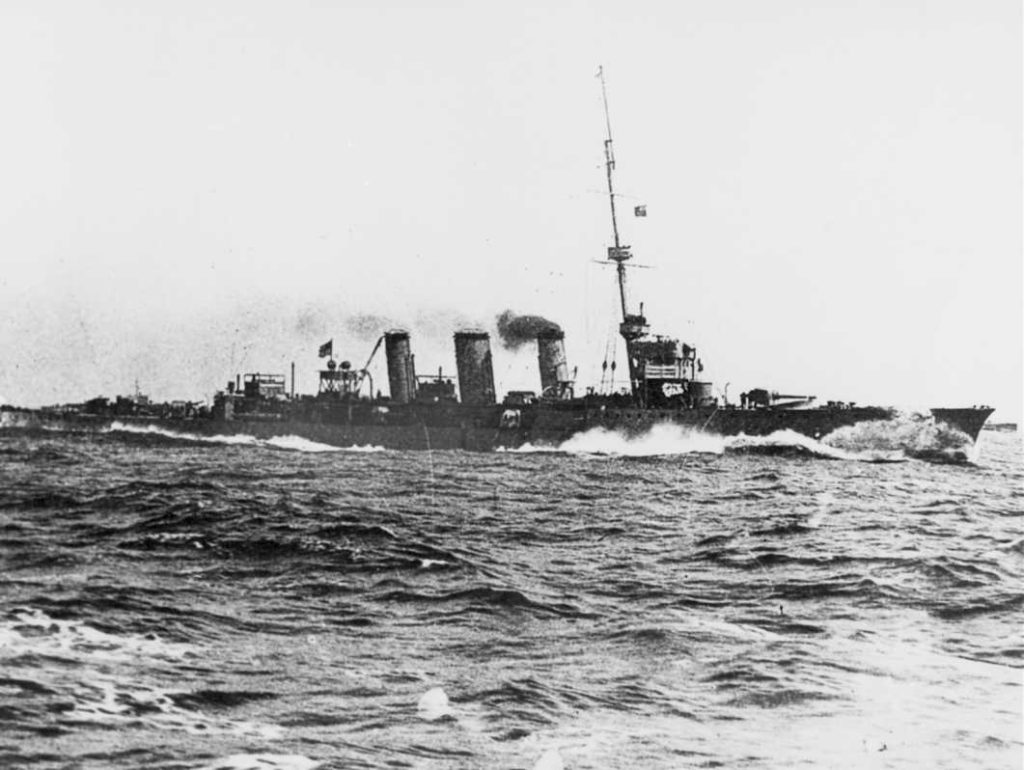
HMS Curlew
HMS Curlew was a C-class light cruiser, part of the Ceres group of the C class of cruisers. She was laid down by Vickers Limited on 21 August 1916, and launched on 5 July 1917, being commissioned into the navy on 14 December 1917. By 1936 she had been placed in reserve at the Nore, where she was commanded by Augustus Agar until early 1937. On the outbreak of war she was commanded by Captain Basil Charles Barrington Brooke, and served with the Home Fleet. She participated in the Norwegian Campaign, and whilst operating off the Norwegian coast, she came under attack from German Ju-88 bombers and was sunk in Lavangsfjord, Ofotfjord near Narvik on the 26th May 1940.
HMS Danae
-
Type. Light Cruiser
-
Class. D
-
Pennant. D44, 32
-
Builder. Armstrong Whitworth
-
Ordered. 1915
-
Laid Down. 01/12/1916
-
Launched. 26/01/1918
-
Commissioned. 22/07/1918
-
Speed. 29 knots
-
Fate. Scrapped 27/03/1948
-
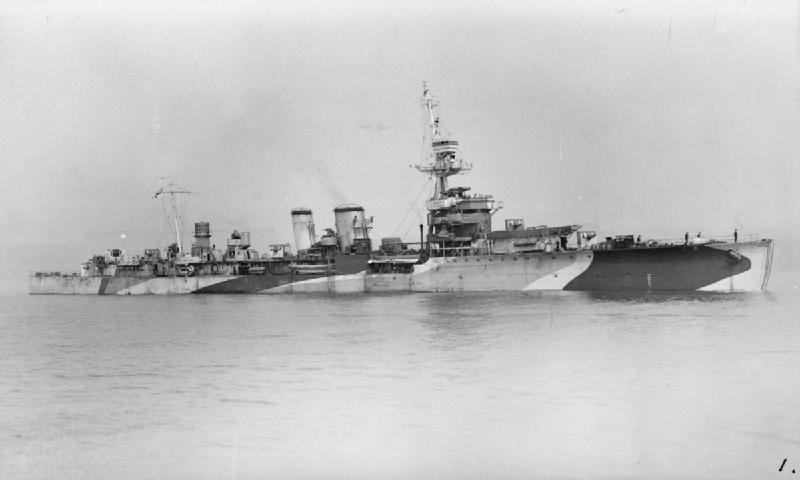
HMS Danae
HMS Danae was a D Class Light Cruiser laid down on 1 December 1916 in the Armstrong Whitworth Shipyard in Walker-on-Tyne and launched on 26 January 1918. The lead ship of her class, she was one of the fastest cruisers of her times. Attached to the Harwich-based 5th Light Cruiser Squadron, she took part in several North Sea patrols during the last months of World War I. Between October and November of the following year; she passed to the Baltic Sea, where she supported the Whites in the Russian Civil War.
On 22 January 1948 she was sold to T.W. Ward company and scrapped following 27 March 1948 in the Vickers Armstrong shipyard in Barrow-in-Furness.
HMS Dauntless
- Type. Light Cruiser
- Class. Danae
- Pennant. D45, 71
- Builder. Palmers
- Ordered. 1916
- Laid Down. 03/01/1917
- Launched. 10/04/1918
- Commissioned. 22/11/1918
- Speed. 29 knots
- Fate. Scrapped 13/02/1946
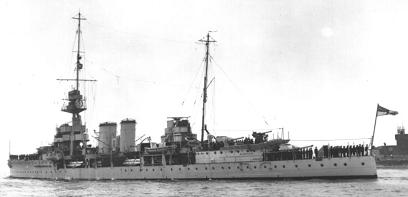
HMS Dauntless
HMS Dauntless was a Danae-class light cruiser. She was launched from the yards of Palmers Shipbuilding and Iron Company on 10 April 1918 and commissioned on 22 November 1918. In May 1928 Dauntless was recommissioned and assigned to the America and West Indies Station. She ran aground in July off Halifax, Nova Scotia, and was badly damaged, suffering the breach of her engine room and of her one boiler rooms. Subsequently all of her guns, torpedo tubes and much of her other equipment had to be removed to lighten the ship. She was finally re-floated and towed off by her sister, HMS Despatch, and a number of tugs. She was repaired throughout 1929 and was reduced to the reserve.
In 1930 she was transferred back to the America and West Indies Station. During 1931-1933 she served with the South American Division, and in 1934 she relieved HMS Curlew in the Mediterranean and was reassigned to the 3rd Cruiser Squadron. In 1935 she returned to Britain to be paid off into the reserve.
She was sold to be broken up for scrap on 13 February 1946, and in April that year was broken up at the yards of T.W. Ward, of Inverkeithing.
HMS Desperate
- Type. Cruiser
- Class. Danae
- Pennant. D40, P50, D26
- Builder. Thornycroft
- Ordered. 10/05/1895
- Laid Down. 01/07/1895
- Launched. 15/02/1896
- Commissioned. 1897
- Speed. 30 knots
- Fate. Scrapped 20/05/1920
-
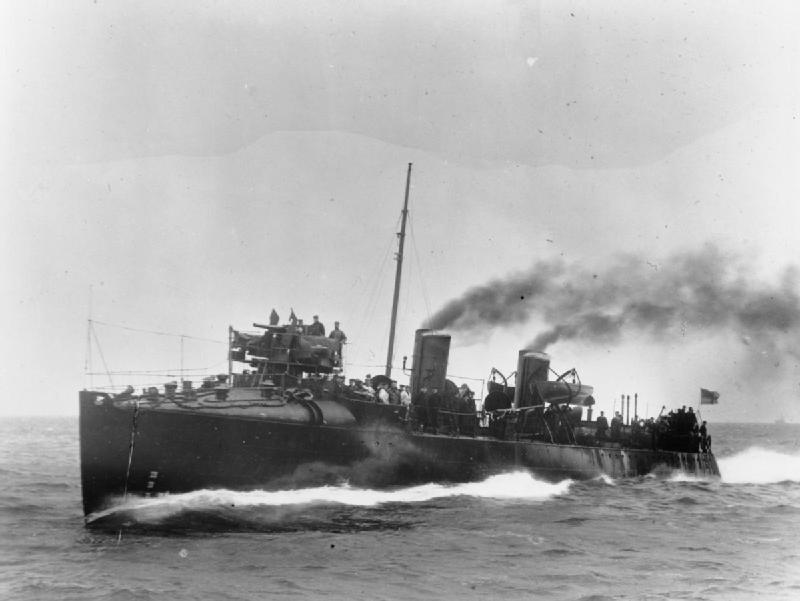
HMS Desperate
HMS Desperate was a Danae class Cruiser laid down at yard number 305 on 1 July 1895 at the John I. Thornycroft & Company shipyard at Chiswick on the River Thames. She was launched on 15 February 1896. After commissioning she was assigned to the Chatham Division of the Harwich Flotilla. On 26 June 1897 she was present at the Royal Naval Review at Spithead in celebration of Queen Victoria’s Diamond Jubilee. She was re-assigned to Sheerness in January 1900 for instructional purposes at the Sheerness school of gunnery.
On 30 August 1912 the Admiralty directed that all destroyer classes were to be designated by letters. She was assigned to the D class along with other destroyers built to the same overall specification. In August 1914 she was in active commission tendered to HMS Excellent, the Portsmouth gunnery school she remained there for the duration of the First World War.
In 1919 Desperate was paid off then laid up in reserve awaiting disposal. She was sold on 20 May 1920 to Thomas W. Ward of Sheffield for breaking at Milford Haven, Wales.
HMS Dido
- Type. Cruiser
- Class. Eclipse
- Pennant. P05, 87
- Builder. London & Glasgow
- Ordered.
- Laid Down. 30/08/1894
- Launched. 20/03/1896
- Commissioned. 1900
- Speed. 18.5 knots
- Fate. Scrapped 1922
-

HMS Dido
HMS Dido was launched on the 20th March 1896 and was the only Eclipse class cruiser not to see active service during the First World War. She had been converted to act as a depot ship before the war, and served as a depot ship for the destroyer flotillas at Harwich through the war. From 1914 to 1915 she supported the 3rd Destroyer Flotilla, from 1915 to 1917 the 9th Flotilla and from then until the end of the war the 10th Flotilla. In 1901 In October 1901 she left Hong Kong homebound, arriving at Sheerness 14 December.
She was paid off at Chatham on 11 January 1902 and was placed in the Fleet Reserve as emergency ship. Sold for breaking in 1922.
HMS Dragon
- Type. Light Cruiser
- Class. D
- Pennant. D46, 19
- Builder. Scott’s
- Laid Down. 24/01/1917
- Launched. 29/12/1917
- Commissioned. 16/08/1918
- Speed. 29 knots
- Fate. Sunk 07/07/1944
-
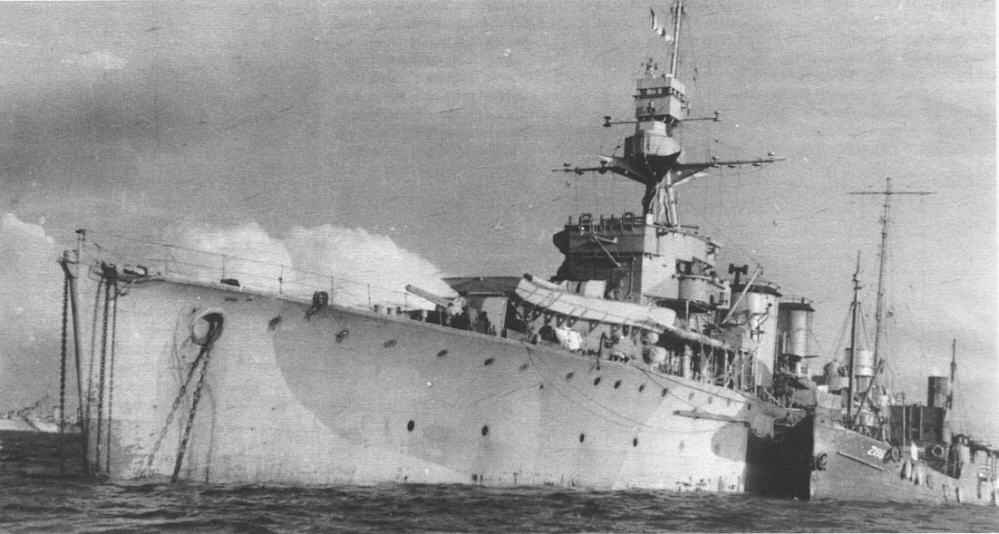
HMS Dragon
HMS Dragon was a Danae Class Light Cruiser launched on the 29th December 1917 by Scott’s of Greenock. it was not until 10 August 1918 she was finally commissioned at Harwich by the Royal Navy as HMS Dragon.In 1919 Dragon was a member of the Baltic Squadron. In January 1920, the cruiser returned to the UK, and then served in the Atlantic Fleet 1st Light Cruiser Squadron participating in the Empire cruise.
In February 1926, Dragon proceeded to the Mediterranean and joined the 1st Cruiser Squadron. In October she was deployed to the China.
On 15 January 1943 she was handed over to the Polish Navy, renamed ORP Dragon and manned by a Polish crew.
On 7 July 1944 Dragon returned to the area off Caen where she was to take part in the final artillery preparations for capturing the city after a month long siege. The following day, at 5:40 am, while waiting for the order to open fire Dragon was hit by a German Neger manned torpedo with the loss of 26 men.
HMS Endymion
- Type. Cruiser
- Class. First class Protected
- Pennant. A6, N17, N41
- Builder. C&W Earle
- Ordered.
- Laid Down. 21/11/1889
- Launched. 22/07/1891
- Commissioned. 26/05/1894
- Speed. 20 knots
- Fate. Scrapped 16/03/1920
-
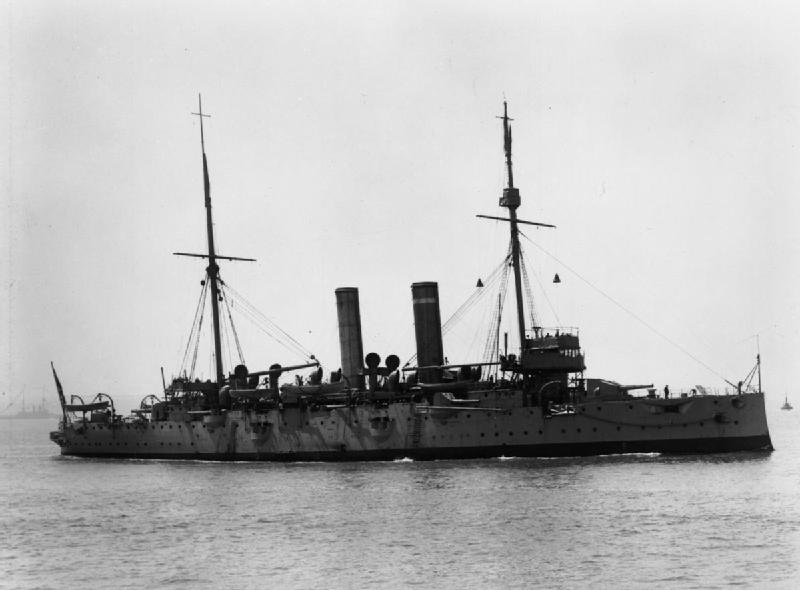
HMS Endymion
HMS Endymion was a first class Protected cruiser, launched on 22 July 1891 by C&W Earle. She took part in suppressing the Boxer Rebellion in China, during which time future rear admiral and VC recipient Eric Gascoigne Robinson served aboard her. In December 1901 she visited Manila, where the Governor and US officers hosted the crew, many of whom they had served together with during the rebellion. She served in the First World War in the Gallipoli Campaign, and was sold for breaking up at Cardiff on 16 March 1920.
HMS Fearless
- Type. Cruiser
- Class. Active
- Pennant. 46, 64, 27
- Builder. Pembroke Dockyard
- Ordered. 1910
- Laid Down. 15/11/1911
- Launched. 12/06/1912
- Commissioned. 1913
- Speed. 25 knots
- Fate. Scrapped 08/11/1921
-
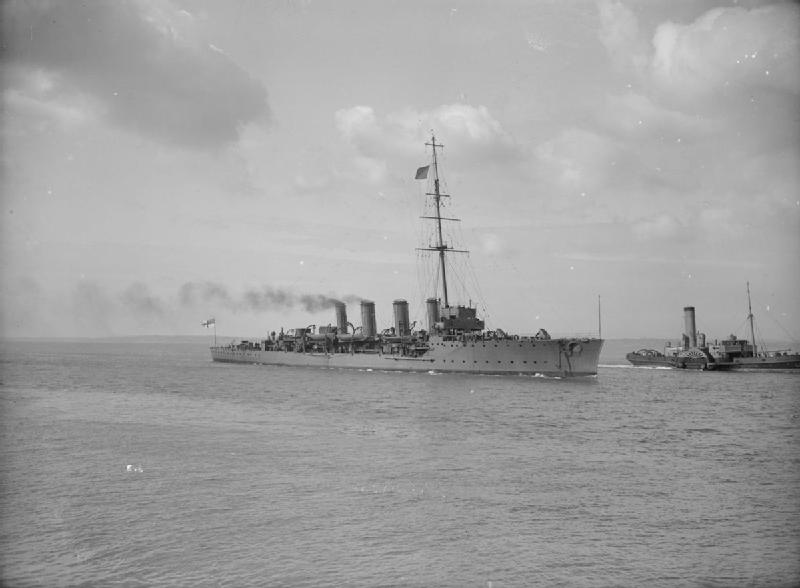
HMS Fearless
HMS Fearless was an Active Class Scout Cruiser launched on the 12th June 1912. At the start of the First World War the 1st Destroyer Flotilla was part of the Harwich force. Her first clash with the Germans came on 18 August. The flotilla was patrolling in the Broad Fourteens when at 6.30 am it encountered a German cruiser believed to be either the Roon or the York. The Fearless was forced to turn and flee, soon escaping from this more powerful but slower opponent. She then encountered the light cruiser Rostock, but by now the flotilla had been scattered, and so once again the Fearless was forced to retreat. At 7.00am the Rostock gave up the chase. The Fearless gathered her destroyers and turned back to chase the German cruiser, but without success.
From 1916 to the end of the war the Fearless was the leader of the 12th Submarine Flotilla of the Grand Fleet, made up of “K” class submarines. On 31 January 1918 she rammed and sank the submarine K 17 in what became known as the “battle of May Island”.
Fearless was repaired and survived the war, but was considered obsolete and was sold for scrapping on 8 November 1921, eventually being broken up in Germany.
HMS Foresight
- Type. Cruiser
- Class. Foresight
- Pennant. D38, N26, N46
- Builder. Fairfield
- Ordered. 1902
- Laid Down. 1903
- Launched. 08/10/1904
- Commissioned. 1905
- Speed. 25 knots
- Fate. Scrapped 03/03/1920
-
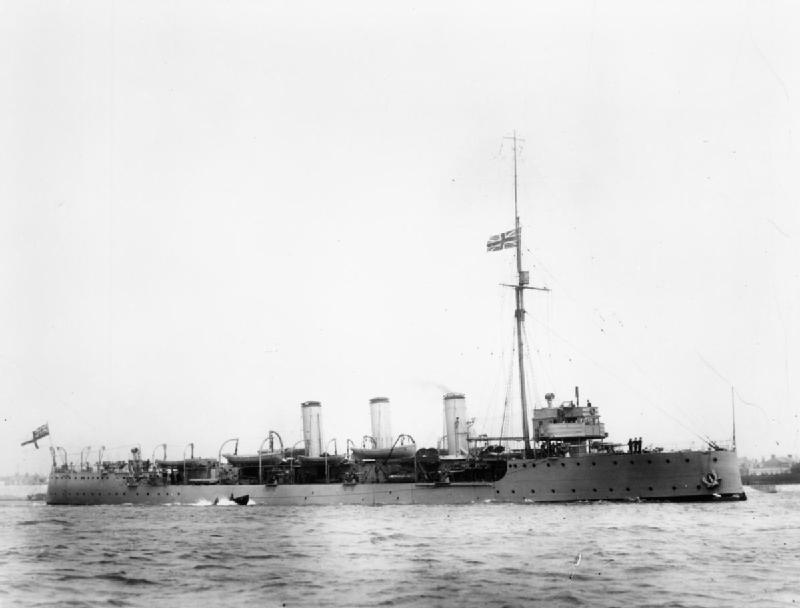
HMS Foresight
HMS Foresight was one of two Forward class scout cruisers of the Royal Navy, built at the yards of Fairfield Shipbuilding and Engineering Company, Govan. She was laid down in October 1903, launched on 8 October 1904 and completed in August 1905. At the start of the First World War she was joined the Dover Patrol, then the 8th Destroyer Flotilla, still at Dover. In this role she took part in the operations off the Flanders coast during October 1914 that helped to protect the Allied flank during the battle of the Yser. In May 1915 she was temporarily moved to the 6th Light Cruiser Squadron on the Humber, guarding against Zeppelin raids on the east coast. She was sold for scrap after the war on 3 March 1920, to Granton S. Breaking Company.
HMS Forth
- Type. Cruiser
- Class. Mersey
- Pennant.
- Builder. Pembroke Dockyard
- Ordered. 1884
- Laid Down. 01/12/1884
- Launched. 23/10/1886
- Commissioned. 1889
- Speed. 17 knots
- Fate. Scrapped 08/11/1921
-

HMS Forth
HMS Forth was a Mersey class cruiser launched on the 23rd October 1886 at Pembroke Dockyard, Following completion she went into reserve at Devonport from 1889-1903, Then served as a Submarine Depot Ship at Devonport 1904-14, and the Humber 1914-16, and Harwich 1916-19. Forth was Sold on the 8th November 1921 to the Slough Trading Co and broken up in Germany.
HMS Galatea
- Type. Cruiser
- Class. Arethusa
- Pennant. 0c, 66, 33
- Builder. Beardmore
- Ordered. 1912
- Laid Down. 09/01/1913
- Launched. 14/05/1914
- Commissioned. 1914
- Speed. 28.5 knots
- Fate. Scrapped 25/10/1921
-
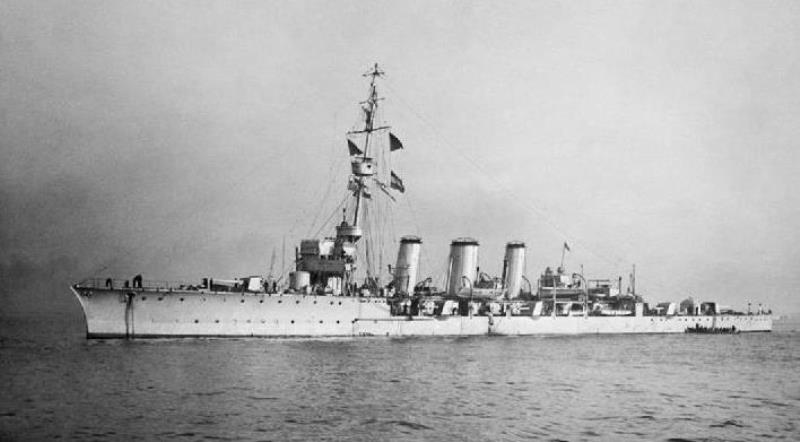
HMS Galatea
HMS Galatea was an Arethusa-class light cruiser of the Royal Navy launched on 14 May, 1914 at William Beardmore and Company shipyard. On her commissioning she was assigned as the leader to the 2nd Destroyer Squadron of the Harwich Force, guarding the eastern approaches to the English Channel. On the 4 May 1916, she took part in the shooting down of Zeppelin L 7. At the battle of Jutland, she was the flagship of the 1st Light Cruiser Squadron under Commodore E.S. Alexander-Sinclair. She was the first ship to report the presence of German ships, triggering the battle. The Galatea was also the first to receive a hit by the German light cruiser SMS Elbing, but no explosion occurred.
Galatea was part of the screen around the Battle Cruiser Force under Admiral Beatty which was on a sweep across the North Sea on 31 May 1916. She was sold for scrapping on 25 October 1921.
HMS Hermes
- Type. Cruiser
- Class. Highflyer
- Pennant. None
- Builder. Fairfield
- Ordered. 1897
- Laid Down. 30/04/1897
- Launched. 07/04/1898
- Commissioned. 05/10/1899
- Speed. 20 knots
- Fate. Scrapped 31/10/1914
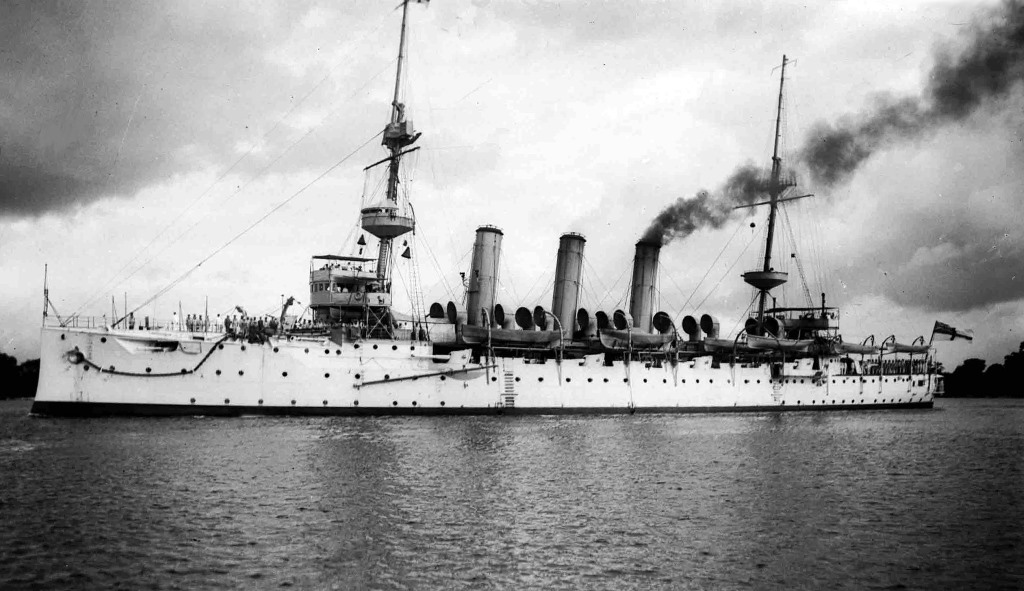
HMS Hermes
HMS Hermes was a Highflyer-Class Cruiser which served with the Royal Navy. She is notable for being refitted in April–May 1913 as the first experimental seaplane carrier of the Royal Navy, with a launching platform and room to stow three seaplanes. Hermes was built at the yards of Fairfield Shipbuilding and Engineering Company, Govan, being laid down in April 1897, launched on 7 April 1898, and commissioned in October 1899. In January 1900 she visited Bermuda and the West Indies. She initially served as the flagship of the East Indies station but was paid off at Devonport in December 1900. She later served at the Cape station (1907-1913). In May 1913, she was re-commissioned as a seaplane carrier. The conversion involved fitting a stowage platform at the rear of the ship and a launching platform at the front. The aircraft took off using wheeled trolleys and were retrieved by cranes. Two seaplanes were carried during trials in 1913.
After the seaplane trials ended in December 1913, Hermes reverted to a cruiser and was recommissioned, only to be taken out of service at the end of the year and placed in reserve.
HMS Hogue
- Type. Cruiser
- Class. Cressy
- Pennant. N59
- Builder. Vickers
- Ordered. 1897-98
- Laid Down. 14/07/1898
- Launched. 13/08/1900
- Commissioned.19/11/1902
- Speed. 21 knots
- Fate. Sunk 22/09/1914
-
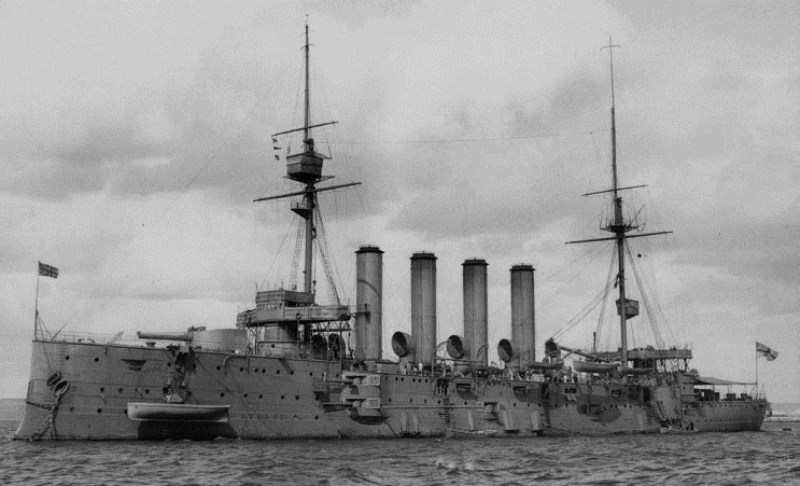
HMS Hogue
HMS Hogue was a Cressy-class armoured cruiser laid down on 14 July 1898 by Vickers, Sons & Maxim at their Barrow-in-Furness shipyard and launched on 13 August 1900. She arrived at Plymouth to begin fitting out in September 1901, and commenced her sea trials in early December. Hogue was completed on 19 November 1902 and assigned to the Channel Fleet until 1904. On 26 November 1909 a coal bunker explosion killed two crewmen.
The ship received a lengthy refit at Chatham Dockyard in 1912–13 and was assigned to the 7th Cruiser Squadron shortly after the outbreak of World War I in August 1914. The squadron was tasked with patrolling the Broad Fourteens of the North Sea in support of a force of destroyers and submarines based at Harwich which protected the eastern end of the English Channel from German warships attempting to attack the supply route between England and France. During the Battle of Heligoland Bight on 28 August, the ship was part of Cruiser Force ‘C’, in reserve off the Dutch coast, and saw no action. Hogue did, however, tow the heavily damaged light cruiser Arethusa, flagship of the commander of the Harwich Force, Commodore Reginald Tyrwhitt, back to port after the battle was over
On the morning of 22 September, Hogue and her sisters, Aboukir and Cressy, were on patrol without any escorting destroyers as they had been forced to seek shelter from bad weather. The three sisters were in line abreast, about 2,000 yards (1,800 m) apart, at a speed of 10 knots (19 km/h; 12 mph). They were not expecting submarine attack, but they had lookouts posted and had one gun manned on each side to attack any submarines sighted. The weather had moderated earlier that morning and Tyrwhitt was en route to reinforce the cruisers with eight destroyers.
U-9, commanded by Kapitänleutnant Otto Weddigen, had been ordered to attack British transports at Ostend, but had been forced to dive and take shelter from the storm. On surfacing, she spotted the British ships and moved to attack. She fired one torpedo at 06:20 at Aboukir that struck her on the starboard side; the ship’s captain thought he had struck a mine and ordered the other two ships to close to transfer his wounded men. Aboukir quickly began listing and capsized around 06:55. As Hogue approached her sinking sister, Captain Wilmot Nicholson realised that it had been a submarine attack and signalled Cressy to look for a periscope although his ship continued to close on Aboukir as her crew threw overboard anything that would float to aid the survivors in the water. Having stopped and lowered all her boats, Hogue was struck by two torpedoes around 06:55. The sudden weight loss of the two torpedoes caused U-9 to broach the surface and Hogue ’s gunners opened fire without effect before the submarine could submerge again. The cruiser capsized about ten minutes after being torpedoed as all of her watertight doors had been open and sank at 07:15.
Cressy attempted to ram the submarine, but did not hit anything and resumed her rescue efforts until she too was torpedoed at 07:20. She too took on a heavy list and then capsized before sinking at 07:55. Several Dutch ships began rescuing survivors at 08:30 and were joined by British fishing trawlers before Tyrwhitt and his ships arrived at 10:45. The combined total from all three ships was 837 men rescued and 62 officers and 1,397 enlisted men lost. Of these, Hogue lost a total of 48 men.
HMS Inconstant
- Type. Cruiser
- Class. Arethusa
- Pennant. 5a, 73, 77
- Builder. Beardmore
- Ordered. 1912
- Laid Down. 03/04/1913
- Launched. 06/07/1914
- Commissioned. 1915
- Speed. 28.5 knots
- Fate. Scrapped 09/05/1922
-
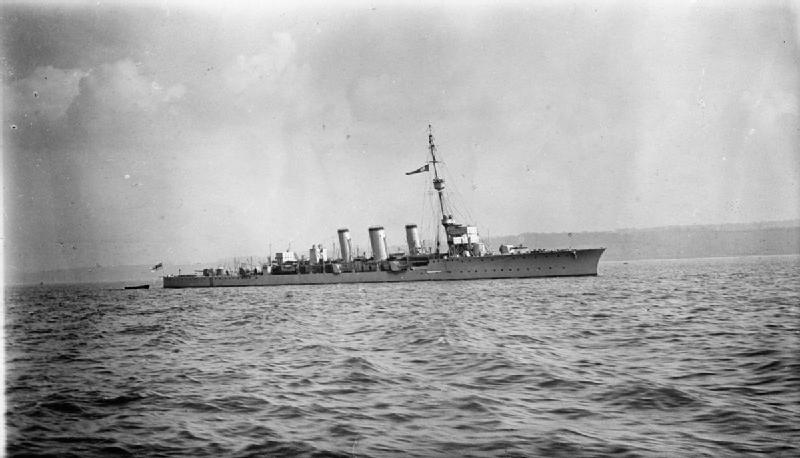
HMS Inconstant
HMS Inconstant was an Arethusa-class light cruiser of the Royal Navy launched on 6 July, 1914 at William Beardmore and Company shipyard. On being commissioned, she was assigned to the 1st Light Cruiser Squadron of the Grand Fleet, and on 31 May to 1 June 1916 Inconstant took part in the Battle of Jutland. She survived the battle and the First World War, and was sold for scrapping on 9 June 1922 to Cashmore, of Newport.
HMS Minerva
- Type. Cruiser
- Class. Eclipse
- Pennant. P32, P1A, P7A
- Builder. Chatham Dockyard
- Ordered. 1893-94
- Laid Down. 4/12/1893
- Launched. 23/09/1895
- Commissioned. 04/02/1897
- Speed.18.5 knots
- Fate. Scrapped 05/10/1920
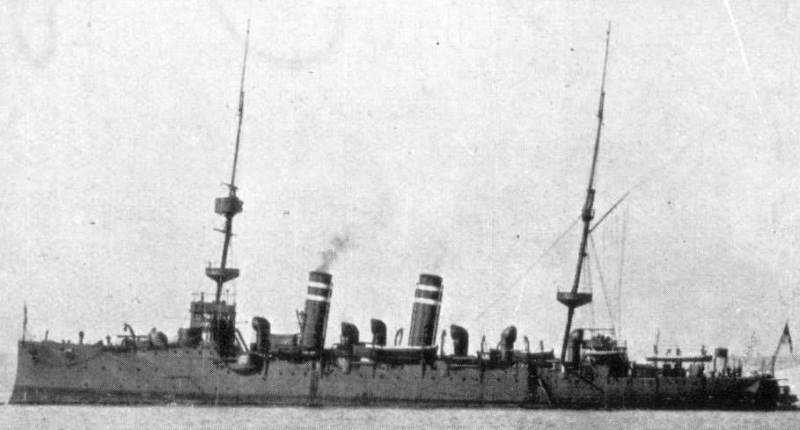
HMS Minerva
HMS Minerva was an Eclipse Class protected Cruiser launched on the 23rd September 1895 The ship was laid down at Chatham Dockyard, Kent, on December 4, 1893. On the outbreak of the First World War in August 1914, Minerva was part of the 11th Cruiser Squadron based in Ireland, but was detached to join the 5th Cruiser Squadron in September, with the responsibility of intercepting enemy merchant shipping trying to return to Germany or Austria. During these operations it captured and scuttled the Austrian merchant ship Bathori. Minerva escorted a troop convoy from Britain to Egypt in November 1914, and formed part of the Allied naval forces supporting the Gallipoli Campaign. When the Turkish torpedo-boat Demirhisa attempted to attack Allied troop ships near Chios on 16 April 1915, Minerva, together with the destroyers Jed, Kennet and Wear, forced Demirhisa to run aground, where the Turkish torpedo boat was later destroyed. Minerva supported the landing at Cape Helles in April and at Sulva Bay in August.
Minerva was deployed to the China Station in 1916, and then to the Indian Ocean and Red Sea in 1917, then remaining off East Africa until the end of the war. She returned to Queenstown, Ireland in 1920 and was sold for scrapping on 5 October 1920.
HMS Pandora
- Type. Cruiser
- Class. Pelorus
- Pennant. N/A
- Builder. Portsmouth Dockyard
- Ordered. 1897
- Laid Down. 03/01/1898
- Launched. 17/01/1900
- Commissioned. 1901
- Speed. 20 knots
- Fate. Scrapped 1913
-
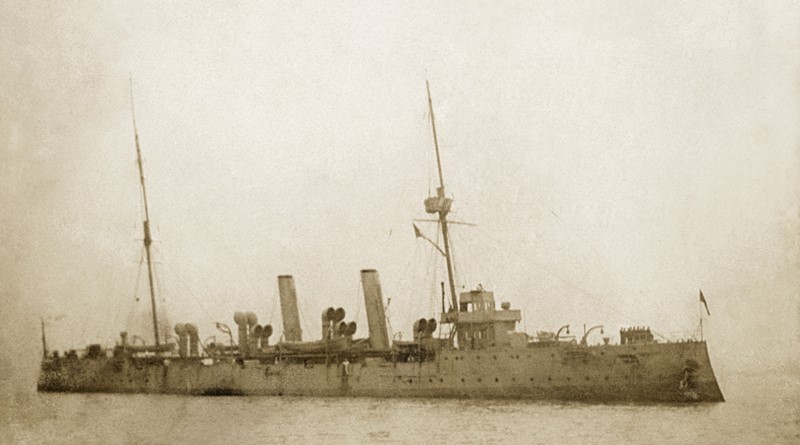
HMS Pandora
HMS Pandora was a Pelorus Class Cruiser built by Portsmouth Dockyard and launched on the 17th January 1900. There were eleven “Third class” protected cruisers in the class, which was designed by Sir William White. While well-armed for their size, they were primarily workhorses for the overseas fleet on “police” duties and did not serve with the main battle fleet.They displaced 2,135 tons, had a crew complement of 224 men and were armed with eight QF 4 inch (102 mm) (25 pounder) guns, eight 3 pounder guns, three machine guns, and two 18 inch (457 mm) torpedo tubes. With reciprocating triple expansion engines and a variety of boilers, the top speed was 20 knots (37 km/h).
Pandora was sold for scrap in July 1913.
HMS Pathfinder
- Type. Cruiser
- Class. Pathfinder
- Pennant.
- Builder. Cammell Laird
- Ordered. 1902
- Laid Down. 1903
- Launched. 16/07/1904
- Commissioned. 18/07/1905
- Speed. 25 knots
- Fate. Sunk 05/02/1914
-
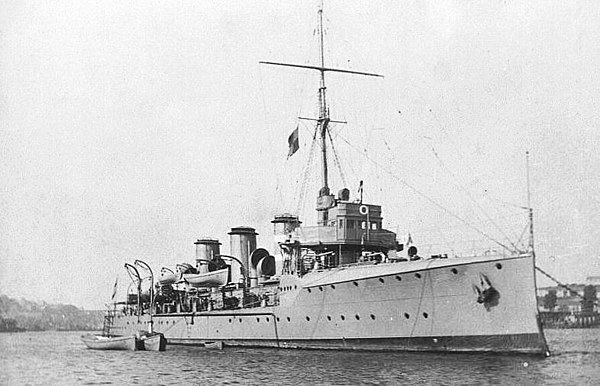
HMS Pathfinder
HMS Pathfinder was a Pathfinder Class Cruiser built by Cammell Laird, Birkenhead and launched on 16th July 1904, and commissioned on 18 July 1905. At the beginning of September 1914 Otto Hersing of U-21 ventured to the Firth of Forth, home to the major British naval base at Rosyth. Hersing is known to have penetrated the Firth of Forth as far as the Carlingnose Battery beneath the Forth Bridge. At one point the periscope was spotted and the battery opened fire but without success. Overnight Hersing withdrew from the Forth, patrolling the coast from the Isle of May southwards. From distance, on the morning of 5 September he observed the SSE course of HMS Pathfinder followed by elements of the 8th Destroyer Flotilla. The destroyers altered course back towards the Isle of May at midday while HMS Pathfinder continued her patrol, Hersing spotted Pathfinder on her return journey from periscope depth at 1530. This time he resolved to make an attack. At 1543 Otto Hersing fired a single 50 cm (20 in) Type G torpedo.
5 September was a sunny afternoon. At 1545 lookouts spotted a torpedo wake heading towards the starboard bow at a range of 2,000 yards. The officer of the watch, Lieutenant-Commander Favell gave orders for the starboard engine to be put astern and the port engine to be set at full ahead while the wheel was fully turned in an attempt to take avoiding action. At 1550 the torpedo detonated beneath the bridge. The cordite charges may have then been ignited, leading to a flash causing a second, massive explosion within the fore section of the ship as the magazine blew up. The fore mast and No 1 funnel collapsed and then toppled over the side disintegrated. He ordered the stern gun to be fired. The king-pin must have been fatally damaged by the explosion because after firing a single round, the gun toppled off its mounting, rolled around the quarter deck, struck the after screen then careered over the stern, taking the gun crew with it. There was no list but there was insufficient time to lower boats. Indeed the remains of a lifeboat davit and rope can still be seen on the wreck. The propeller belonging to the ship’s boat lies on the deck nearby.Lt (E) Stallybrass recalled that the bulkheads held firm until five minutes after the big explosion:
HMS Penelope
- Type. Cruiser
- Class. Arethusa
- Pennant. 8a, 92, 17
- Builder. Armstrong Vickers
- Ordered. 1912
- Laid Down. 01/02/1913
- Launched. 25/08/1914
- Commissioned. 1914
- Speed. 28.5 knots
- Fate. Scrapped 1924
-
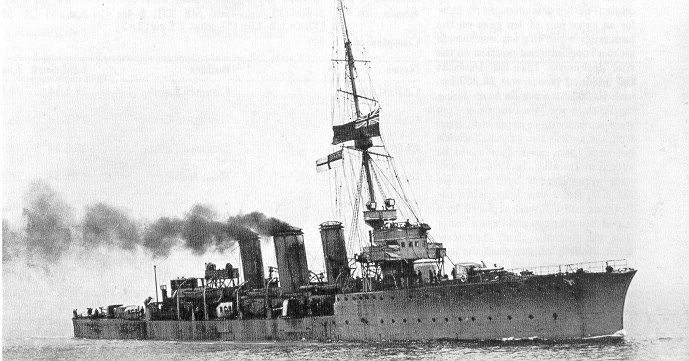
HMS Penelope
HMS Penelope was a Arethusa Class light Cruiser that was based at Harwich during the First World War. She was launched on the 25th of August 1914 and entered service in December 1914, as part of the Harwich Light Cruiser Squadron, before joining the 5th Light Cruiser Squadron, still at Harwich in August 1915. While with the 5th LCS, Penelope took part in the March 1916 raid on the German base at Hoyer (Sylt). On 25 April 1916 she was one of the ships sent to sea to track down the German ships that had attacked Lowestoft. She was hit by a torpedo from UB 29, which destroyed her rudder and steering gear, but she was still able to maintain 20kts, and reached home in safety. Commodore Tyrwhitt, commander of the Harwich force, was not allowed to make his way to sea during the battle of Jutland, so Penelope took no part in that battle.
In January 1917 she took part in an operation launched by the Harwich Force to intercept German destroyers sailing to Zeebrugge. The operation failed, partly because the captains involved came from both Harwich and the Grand Fleet, and Tyrwhitt had not had time to train them all to anticipate his wishes.
She survived to the end of the First World War and was sold for scrapping in October 1924 to Stanlee of Dover.
HMS Royalist
- Type. Light Cruiser
- Class. Arethusa
- Pennant. 4a, 6a, 75
- Builder. Beardmore
- Ordered. 1912
- Laid Down. 03/06/1913
- Launched. 14/01/1915
- Commissioned. 1915
- Speed. 28.5 knots
- Fate. Scrapped 24/08/1922
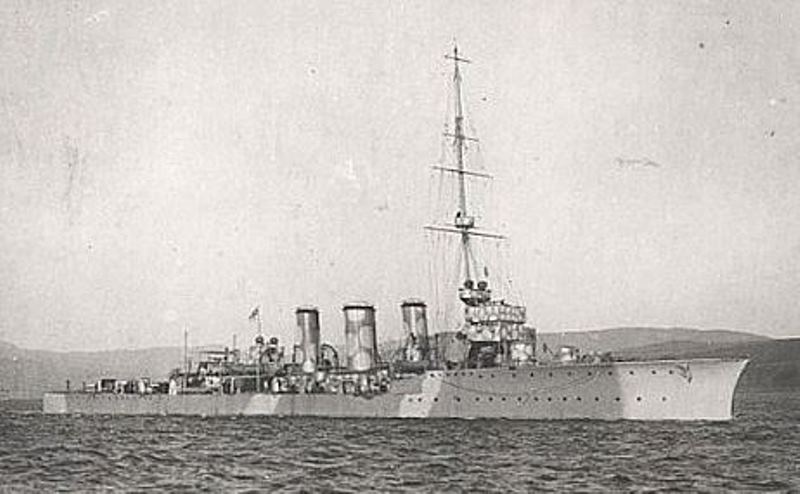
HMS Royalist
HMS Royalist was an Arethusa Class light Cruiser of the Royal Navy launched on 14 January 1915 at William Beardmore and Company’s shipyard. On being commissioned, she was assigned to the 4th Light Cruiser Squadron of the Grand Fleet, and on 31 May to 1 June 1916 Royalist took part in the Battle of Jutland. She survived the battle and in February 1917 was reassigned to the 1st Light Cruiser Squadron of the Grand Fleet. Royalist spent four months in the Baltic and then spent the rest of the year with the 2nd Light Cruiser Squadron at Harwich. She survived to the end of the First World War, and was sold for scrapping on 24 August 1922 to Cashmore, of Newport.
HMS Spartiate
- Type. Cruiser
- Class. Diadem
- Pennant.
- Builder. Pembroke Dock
- Ordered. 1896-97
- Laid Down. 10/05/1897
- Launched. 27/10/1898
- Commissioned.
- Speed. 20 knots
- Fate. Scrapped 1932
-
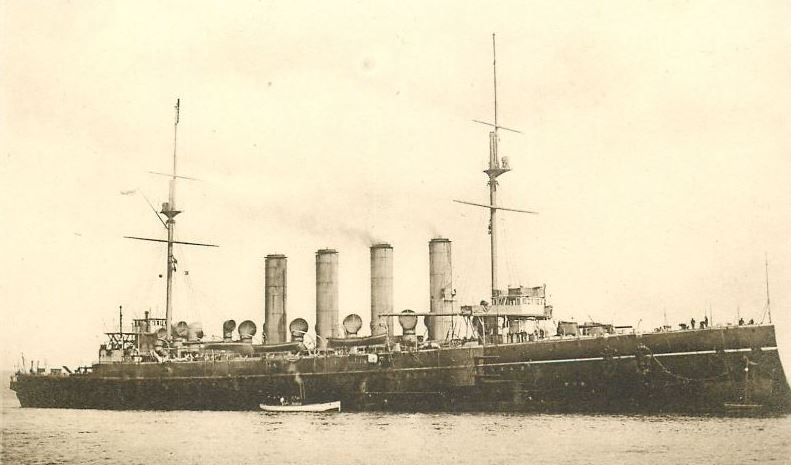
HMS Spartiate
HMS Spartiate was a Diadem-class of protected cruiser in the Royal Navy. She was built at Pembroke Dock and launched on October 27, 1898. She was a stokers’ training ship in 1914 and was renamed Fisgard in June 1915. She survived the War and was sold in July 1932. She returned to Pembroke to be broken up.
HMS St George
- Type. Cruiser
- Class. Edgar
- Pennant. N31, N88
- Builder. C&W Earle
- Ordered. 1889
- Laid Down. 23/04/1890
- Launched. 23/06/1892
- Commissioned. 25/10/1894
- Speed. 20 knots
- Fate. Scrapped 01/07/1920
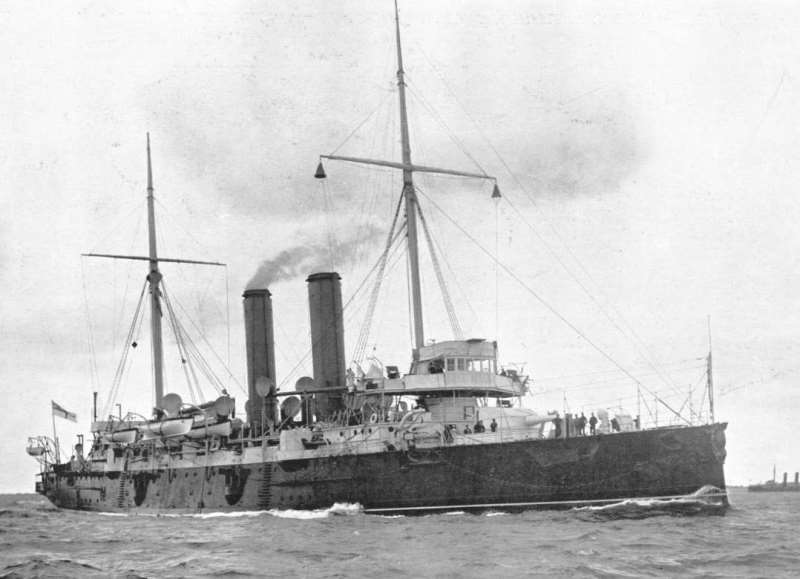
HMS St George
HMS St George was a first class Cruiser of the Edgar class. She was launched on June 23rd 1892 by C&W Earle. In 1901, she was one of two escort ships for HMS Ophir, which carried the Duke and Duchess of Cornwall and York (later King George V and Queen Mary) during their tour of the British Empire. She was the flagship of the Cape & West Africa Station (Rear-Admiral Harry Rawson) based at Simon’s Town, and served in the First World War. She was designated as a depot ship in 1909, and sold for breaking up at Plymouth on July 1st 1920.
HMS Suffolk
- Type. Cruiser
- Class. Monmouth
- Pennant. 20
- Builder. Portsmouth Dockyard Ordered.
- Laid Down. 25/03/1901
- Launched. 15/01/1903
- Commissioned. 21/05/1904
- Speed. 23 knots
- Fate. Scrapped 01/07/1920
-
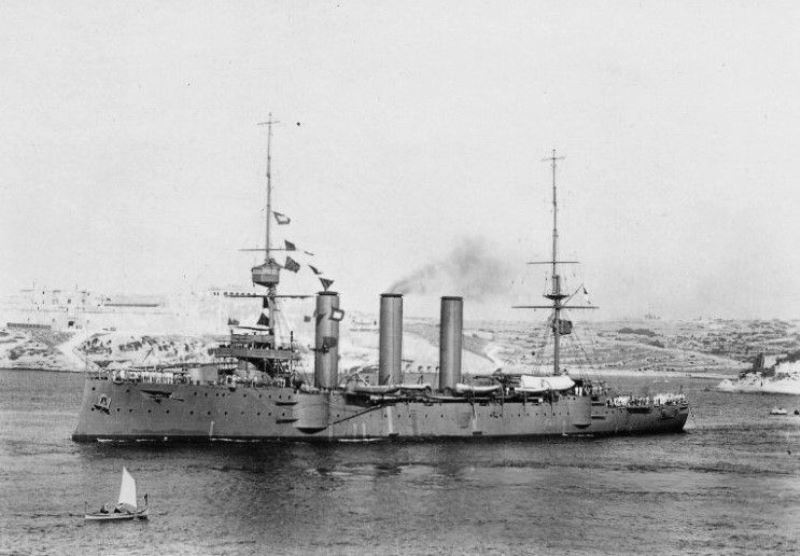
HMS Suffolk
HMS Suffolk was one of 10 Monmouth-class armoured Cruisers built for the Royal Navy in the first decade of the 20th century. Launched at Portsmouth Dockyard on the 15th January 1903. Upon completion she was assigned to the 3rd Cruiser Squadron of the Mediterranean Fleet and was then assigned to the 3rd Cruiser Squadron in the Mediterranean in 1909 after a lengthy refit. She returned home for another refit in 1912 and became the flagship of the 4th Cruiser Squadron on the North America and West Indies Station in 1913.
After the beginning of World War I in August 1914, Suffolk became a private ship and searched for German commerce raiders while protecting British shipping. She captured a German merchantman shortly after the war began. She remained in the Atlantic until she became flagship of the China Station in 1917 In late 1918 the ship was deployed to Vladivostok to support the Siberian Intervention during the Russian Civil War. She returned home in 1919 and became a briefly became a training ship before she was sold for scrap in 1920.
HMS Undaunted
-
Type. Cruiser
-
Class. Arethusa
-
Pennant. 2c, A5, 80
-
Builder. Fairfield
-
Ordered. 1912
-
Laid Down. 21/12/1912
-
Launched. 28/04/1914
-
Commissioned. 1914
-
Speed. 28.5 knots
-
Fate. Scrapped 09/04/1923
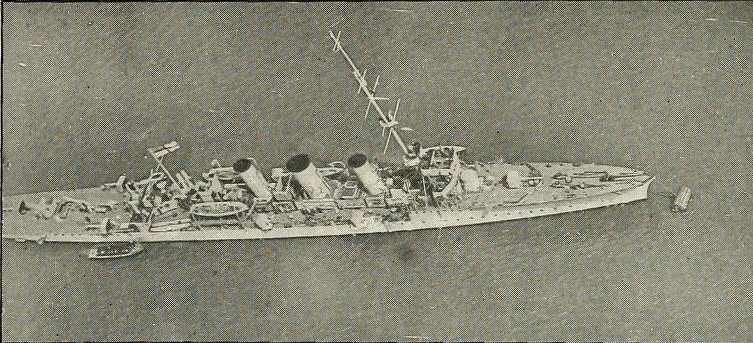
HMS Undaunted
HMS Undaunted was a Arethusa class light Cruiser launched on the 28th of April 1914 by Fairfield Shipbuilding. She spent almost the entire war with the Harwich Force, joining it as the leader of the 3rd Destroyer Flotilla at the end of August 1914. On 17 October she led four destroyers of her flotilla against a force of four German destroyers off the Dutch coast. The four German destroyers (S 115, S 117, S 118 and S 119) were all sunk during the engagement. In November 1914 she was part of the force mobilised in an attempt to catch the German ships that had raided Gorleston (part of Yarmouth). Unlike most of the British ships involved, she made contact with German cruisers, and attempted to draw then on to more powerful forces, but without success.
On 24 January 1915 she was present at the battle of Dogger Bank, but did not get involved in the main fighting. She then moved to the Irish Sea, with her destroyers, to undertake anti-submarine duties. On 9-12 February they escorted the Canadian division from Britain to France. On April 1915 she was badly damaged in a collision with the destroyer Landrail, the first of two collisions in her career.
In November 1918 Undaunted left the Harwich Force, and joined the 7th Light Cruiser Squadron of the Grand Fleet, remaining there until March 1919. The next month she joined the Nore Reserve. At the start of 1921 she was reactivated to carry troops to the Mediterranean, before returning to the reserve.
PHOTO GALLERY
We are adding more information to this site on a regular basis, if you wish to submit any photos or provide any information on naval vessels that were based or visited Harwich, then please use the contact page at the bottom of the screen.
Copyright Ownership.
We attempted to get the consent of copyright holders to use this material for nearly all of the photographs on the website.
In the few cases where names are available, a thorough search was made using telephone directories, photographic copyright directories, People Search and Google Area Search. None of the copyright owners could be traced in this way and we believe we have exhausted all reasonable avenues.
The consensus opinion of these authorities was that if any two of the following situations applied we would be deemed to have taken sufficient action to avoid infringing copyright laws:
- Reasonable efforts made to contact the copyright holder
- No financial gain will be made in relation to the photos
- A letter is obtained from present owner of photos
- There is a proviso included stating that if offence is caused document will be removed
The website owner undertakes to remove any photograph from the website where offence is caused. All the above conditions have therefore been met.
← Cruisers – World War 2 Battleships & Frigates – World War 2 →
